#polish suffragettes
Text
On this day, 105 years ago, after fighting for a long time, Polish women finally got the right to vote.
On November 28th 1918 the real democracy started in Poland 🇵🇱
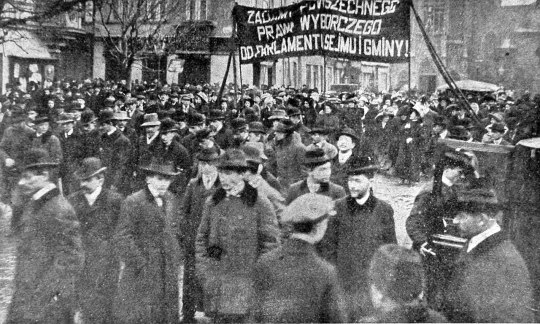
Polish suffragettes protesting in Kraków, 1911
#radfem#radical feminism#radfem safe#radblr#radfems do interact#feminism#radfems do touch#women's rights#women's liberation#adult human female#suffragettes#suffragette#women voters#right to vote#democracy#feminist#polish#poland#polish suffragettes#prawa kobiet#polska#1918#demokracja#prawa wyborcze#prawa wyborcze kobiet#polish history#polska historia#mine
34 notes
·
View notes
Text

Władysława Habicht (deceased)
Gender: Female
Sexuality: Lesbian
DOB: 1 June 1867
RIP: 2 April 1963
Ethnicity: White - Polish
Occupation: Suffragette, activist, telegraphist, poet, musician
Note 1: Founded Association of Galician Postal Clerks, since at that time only unmarried women were accepted to work in post offices, the association served as a labour union and community that provided the workers with a sense of group belonging, financial aid, and support. The group's postulates emphasized the importance women's emancipation, which would allow them workers rights; including overtime pay, holidays, sick pay and a better retirement pension. They also demanded equal treatment in employment for positions and departments previously restricted to men.
Note 2: In recognition of her achievement, Habicht received the Silesian Plebiscite Badge, the Silver Cross of Merit and the Golden Cooperative Badge. At the end of her life, she was looked after by the members of the Society she ran.
#Wladyslawa Habicht#Władysława Habicht#lgbt history#lesbian history#lgbtq#female#lesbian#1867#rip#historical#white#polish#suffragette#activist#telegraphist#poet#musician
102 notes
·
View notes
Text
The Reasonableness Theory of Good Omens

I’ve never done a Tumblr post before, but I’m going to have a go at it now, because the heaven/hell logics in the original Good Omens book (see also: the tv show The Good Place and also Terry Pratchett’s Discworld series generally) were foundational to the development of my theory of human behaviour – and I think it now explains A LOT about the Aziraphale/Crowley ending of Good Omens 2, and also what’s going wrong with us as a society.
So long story short – I’m a Cultural Studies academic at the University of Bristol, and I recently published a ‘smart thinking’ book called On Being Unreasonable: Breaking the Rules and Making Things Better (in bookshops now with Faber & Faber!). Here I explain how demands to “just be reasonable!” have been weaponised throughout history to halt social progress, from the suffragettes to Stonewall to the Civil Rights movement, up to the uproar over Black Lives Matter and Just Stop Oil protests today. Basically, what I think biblical-satire shows like Good Omens and The Good Place are satirising is exactly this: the inherent moral UNREASONABLENESS of the ‘reasonable person’, who wants things to be better but isn’t willing to break any rules to achieve it – even if those rules are bafflingly unfair and nonsensical (like the Job plotpoint, where Aziraphale began to realise this for the very first time).
When I say the ‘reasonable person’, I’m talking about the ‘moderate’ whom Dr Martin Luther King famously described in his Letter from Birmingham Jail as being almost worse than the ‘evil’ side of the out-and-out racist. This is the so-called ‘good’ side, who talk the language of progress whilst getting in the way of any attempt to realise it because they are “more devoted to ‘order’ than to justice”. In On Being Unreasonable I trace an overarching tendency to value the APPEARANCE of reasonableness (calm voices, shiny smiles, dapper suits) over the messy impoliteness of standing up and fighting back. In other words, rather than Heaven being the good guys and Hell the bad guys, Good Omens exposes how BOTH sides end up doing bad things because they’re unwilling to rebel against authority, break unjust rules/laws, and actually do what is RIGHT. We saw this especially clearly, I think, in the hell fire/holy water scene: one side might be ugly and the other side beautiful, but both sides are shown to be monstrous. “Just shut your stupid mouth and DIE already!” is still evil even though it’s said through a smile rather than a scowl.
This is where Crowley comes in. Crowley sees Heaven for who they really are. And this is why he resents being called ‘nice’ – because the qualities of niceness have historically been used as cover for tremendous evil – like how God’s ineffable command to kill Job’s children was morally horrifying, but how the Angels’ smiling promise to replace them with new children made a terrible thing seem like an act of divine grace. In many ways I’m saying nothing new here at all, I know – ‘omg the good side are actually the baddies! gasp!’ is hardly a novel literary interpretation. But it’s a bit more complicated than just that. What I’m talking about here is the specific sociopolitical mechanism by which reasonable appearances have been confused with actual moral goodness – and how this impulse to see ‘nice’ and think ‘good’ has historically been weaponised against us. It’s this that Good Omens really exposes. As I say in On Being Unreasonable, we can see this everywhere. “Think about the honeyed gentility of the American South, where smiling courtesy provided cover for simmering racial violence. Think about the buttoned-up laced-down aggression of the white imperial invader, sitting on their verandas in the Indian sunshine sipping tea. Think about the polished performances of the Nazis, with all their approving 1930s newspaper articles about impeccable manners and rarified tastes in art and dress”. In fact, there’s even an adjective for this: ‘Minnesota Nice’, which is often used as a backhanded compliment to refer to people who avoid confrontation in favour of a veneer of false politeness, and for whom calling out homophobia/racism/misogyny/etc is unforgivably rude. Nice, in this sense, can never be good, because it is being used to advance evil.
In Good Omens, what we saw is how deeply Aziraphale longs to break free from this logic, but how he can’t yet quite manage to free himself from that sense of reasonable idealism – the belief that surely the ‘good’ side of this broken system can be reformed from within. Meanwhile, Crowley is clearly being depicted as a fallen Angel in the true sense – someone who realises that the system itself is rotten to the core, and is willing to ask the hard questions and break rules in pursuit of truly moral actions, even if it costs him everything. Crowley has bitterly learned never again to make the mistake of confusing order with justice; this is a lesson that Aziraphale still needs once and for all to learn.
In the conclusion to On Being Unreasonable I set out a kind of matrix of behaviour to explain all this, where the Unreasonably-Unreasonable people are – like Hell! – “the deliberate contrarians and hate-speech purveyors and greed-is-good libertarian individualists, who think they can say and do whatever they want without consequences no matter the harm to anyone else”. Meanwhile, like Heaven, a lot of self-professedly progressive people seem to have become “so determined not to be like them that we’ve become something just as bad” – namely, Unreasonably-Reasonable people, “obsessed with tone-policing and respectability politics and endless toothless debate, happy to act the devil’s advocate and platform hate-speech and injustice so long as everyone appears to be doing it politely”. What I think we’ll see unfolding in Good Omens 3 is the revelation that what the world ACTUALLY, desperately needs is more people like Crowley, the Reasonably-Unreasonable people on whom social progress has always depended: “those who understand that civic dissent and smashing down racist statues and no-platforming bigots might sometimes be the only way to make the world a better place”.
So if God (and Neil Gaiman) really does have an ineffable plan then maybe it was this. Crowley needed to fall then, and Aziraphale needs to try to reform Heaven and fail spectacularly now, in order for us all collectively to rid ourselves of that morally-unreasonable urge to seem reasonable in the face of great injustice forever.
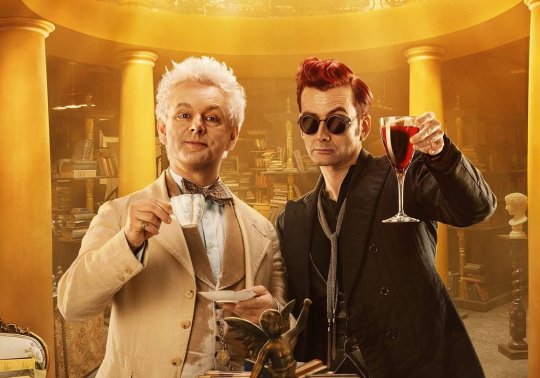
#good omens#good omens meta#aziraphale#aziracrow#crowley#good omens 2#neil gaiman#michael sheen#david tennant#ineffable husbands#good omens spoilers
100 notes
·
View notes
Text
Infodump about my drama performance :3 (the one for my mock exam)
Tw for racism, sa, homophobia, ableism, sexism and discriminatory stuff like that. Nothing too bad we just look at themes like this in our performance.
So! Some information first. There's 5 people in my group, including me, so our performance has to be 15-20 minutes long. We chose an episodic type of play, and the overall theme is discrimination. We have created 10 scenes at the moment, each looking at different types of discrimination.
The first scene: Our performances opening scene. In this one we explores the theme of migration and islamophobia. Two characters migrate to another country for a better life just to experience discrimination for their religion there.
Second scene: Racism. a split stage is used here- which is basically when the stage is spilt into two different scenes. On the left, the scene is set in 1880s. Black characters walk into a store peacefully when they are told that they are not welcomed there. After that the scene, the scene on the right behinds. This one is set in 2000s where a similar thing happens. It basically shows how racism still exist and stuff.
Third: Sexism. Two characters- a guy and a girl, are sa'd. They have different reactions to that. For the girl, she talks about how she doesn't feel safe to walk outside anymore. The guy tries to tell someone about the sa but they just dismiss it and say that he must've liked it cuz he's a guy.
Fourth: Homophobia. Two gay characters hold hands while walking when some guy comes at them n is mad n say that religion doesn't accept gays or smth . Honestly from this scene forward our scenes aren't really polished we haven't spend much time making them.
Fifth: Remember scene 3? This time the perpetrator is haunted by the ghosts of the ppl he sa'd and we're gonna use like physical theatre to show it n stuff .
Sixth: Sexism. The suffragettes movement shown.
Seventh: Sexism again. This time we show the differences between violent and peaceful protests n stuff .
Eighth: Abliesm. Set in 1900s. We haven't eevn made the scene, we just have an idea of it being physical theatre and mime . We literally came up with this scene yesterday 😭
Ninth: Teen pregnancy. Same as above.
Tenth: Victimisation?? Honestly idk my friend was real unclear about this when she showed me this idea.
Anyways yeah that's it!! We have some other ideas of discrimination, which are: age, parenting, national origin. We desperately need to make our scenes longer but it's hard to just move on and do it cuz we're too busy having to convince the other 3 people in our group to just fucking stop messing around and do the work. And I think our scenes need to looknmore interesting and not too bland,, but hey we have barely began making these imnsure they'll get better with time :33
9 notes
·
View notes
Text
Women fighters, in fiction and in reality, have always fascinated me.
I grew up never getting tired of The Mummy Returns (2001) and its action-packed adventures. It features one of my most favorite cinematic moments: the fight scene between Nefertiri and Anck-su-namun, both tasked to be protectors in the kingdom of Egypt some 3,000 years ago. One may think they must be ahead of their time for training women for battle and assigning such tasks to them.
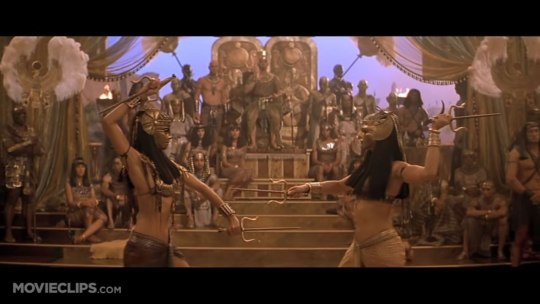
Fight scene from The Mummy Returns (2001)
There are many other scenes in the said film showing both women as their 1930s reincarnation, Evy (Nefertiri) and Meela (Anck-su-namun), fighting with and among men. Not once did Rick, Evy's husband, handed over guns to her to help them battle the enemies and save their son. Their kind of relationship was yet another reason why I have always loved that film.
Seeing The Mummy Returns again for the nth time, I figured these female characters have played a significant part in my upbringing. They showed me women can fight, too, when it was most needed. They didn't have to be the stereotypical damsels in distress waiting to be rescued because they can save themselves while saving others, as well. In retrospect, at such a young age I knew I wanted to be like them. I wasn't very much into the princess thingy, except for the Xena the Warrior Princess kind. In fact, I once dreamed of becoming like the Power Rangers with all their skills and stunts.
Through the years, I have been learning more about Filipinas who left their mark in our history. In an era of a patriarchal society where women were reinforced to be homemakers & deemed as the lesser sex, there were several of them who strayed against the conventions and took part in the never-ending fight for freedom.
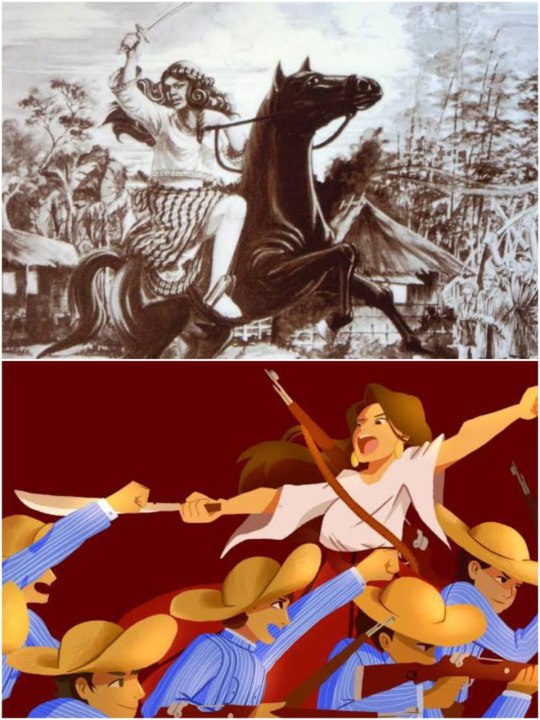
Illustrations of Gabriela Silang (by Carlito Rovira) (top) and the first female general Agueda Kahabagan (from SCOUT Magazine) (bottom) during the Philippine Revolution
One of them was notorious for polishing her nails and putting on red lipstick before going to battle, because she believed she also fought for the freedom to be herself as a woman. Another one used to be a movie superstar until the war. She joined the guerrilla movement to avenge for her husband's murder, and in the process she saved an entire village from being killed by the colonizers.

The women of HUKBALAHAP (Hukbong Bayan Laban sa Hapon), clockwise from left:
Remedios Gomez-Paraiso AKA Kumander Liwayway and her red lipstick (art from Rejected Princesses); Carmen Rosales, movie star-turned guerilla fighter (from Flickr); Felipa Culala AKA Kumander Dayang-Dayang (art by Dos Garcia); and Simeona Punsalan-Tapang AKA Kumander Guerrero (art by @RoriComics on Twitter)
But the courage of Filipina women in history has been witnessed not only at home and in the battlefield. There were women who stood up for their right to receive formal education and their right to vote.

Top photo: a painting of The Women of Malolos (art by Rafael del Casal); bottom photo: U.S. First Lady Florence Harding w/ Filipina suffragette delegation, 1922 (From US-Philippines Society)
There were women who saved people's lives by caring for the injured and the sick and feeding the hungry.
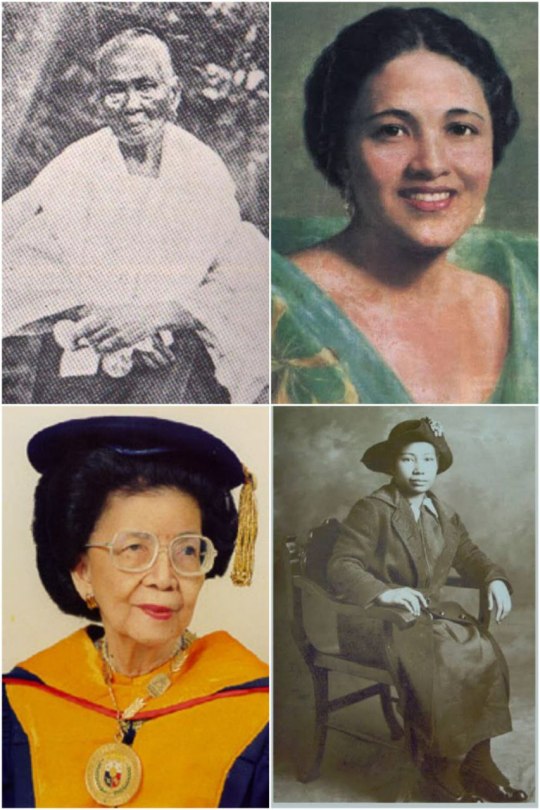
Clockwise from left: Melchora Aquino AKA Tandang Sora (from Wikipedia); Josefa Llanes-Escoda (from Bayaning Filipino on Blogger); Maria Orosa (from Orosa Family); and Dr. Fe del Mundo (from National Academy of Science and Technology)
There were women who continue to fight for justice and for their right to be heard, not just as victims but survivors of a violent, tragic past.
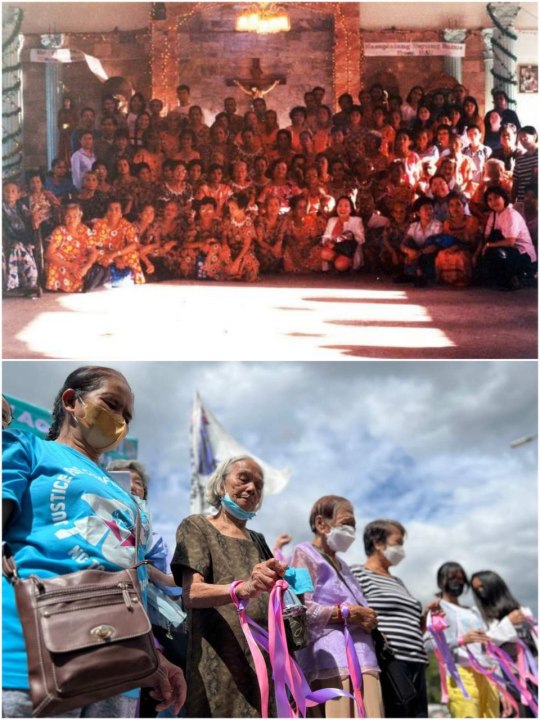
Top photo: the Malaya Lolas of Candaba, Pampanga; bottom photo: the lolas of Lila Pilipina. Both are groups of “comfort women,” survivors of military sexual violence during the Japanese Occupation. (From Facebook)
There were women who prove themselves worthy to be recognized by the world for their talents, abilities, and dedication in their respective fields.
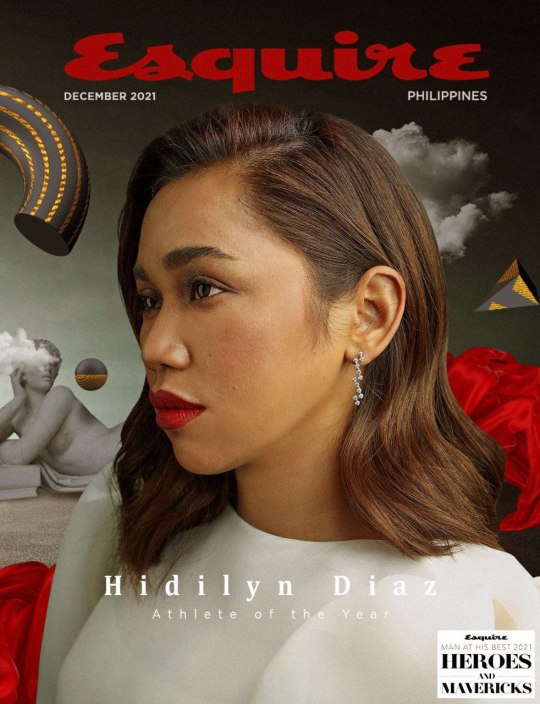

Hidilyn Diaz, the first Filipino Olympic gold medalist; and Maria Ressa, the first Filipino Nobel Laureate (From Esquire Philippines)
There were women leaders who empowered their countrymen towards a better quality of life.

Campaign images of Senator Risa Hontiveros and former Senator Leila de Lima for the 2022 National Elections (From Facebook)

Atty. Leni Robredo, former Vice President of the Philippines (From Esquire Philippines)
And before I forget, I was raised and surrounded by strong women who all the while face their own share of battles in life.
We as women are fighters, and we should never let anyone tell us otherwise.
Meanwhile, I believe I have arrived at a full circle. I may haven't reached my dream of becoming a Power Ranger but who would have thought that as an adult, I would portray a woman fighter myself?
Happy Women's Month!
2 notes
·
View notes
Text
10 examples by creatives specifically from Aotearoa.

Toi T Toi Ora: Contemporary Mori Art is the most important look at modern Maori art ever done. It includes over 300 works by 110 Maori artists from the 1950s to the present day. Four great Maori artists will have their work shown at Britomart.
Shane Cotton's mural Maunga, which is five stories high, is the centrepiece of the Auckland Art Gallery Toi o Tmaki's Toi T Toi Ora: Contemporary Mori Art show at Britomart.
This piece is a drawing of 25 pot designs, each of which represents a New Zealand maunga (place or mountain). Find out more about how Maunga came to be here.

Heart of the City, Fort st, Auckland (2016)
Sara Hughes, a well-known artist from Auckland, made the newest Hearts of the City piece. See for yourself at Fort Lane.
Her Hearts of the City piece is a spectacular burst of colour that makes references to the art deco and heritage places in Auckland.
This heart is full of everything life has to offer, like a sunburst. Sara hopes that its rays will make people feel good and give them hope.
Hughes has gotten a lot of attention from people all over Australasia. In 2005, he won both the Wallace Art Award and the Norsewear Art Award.

Misery (Tanya Jade McMillan) and Tomtom (her husband) made the boards below. They are icons in the New Zealand street art scene, and Misery is one of New Zealand's best-known female pop and wall artists. Tomtom is a tattoo artist, and his style can be seen. In these pictures, you can also see that she has Tahitian and Chinese roots.

Beacon, a new sculpture by Auckland artist Lang Ea made of shiny stainless steel in the shape of a circle, has arrived at Milford Reserve. It is sure to make people feel welcome as they walk their dogs and get some fresh air during the COVID-19 lockdown.
It is even hoped that it might bring a little bit of happiness in these hard times.
Lang Ea says: “This sculpture symbolises and reflects the significant and courageous achievements of the suffragettes more than a century ago and lights the way for women in the present and future.”
In the middle, there is a violet form that looks like a camellia. The people who fought for women's right to vote chose the colour violet to represent honour and self-respect. In Beacon, Violet speaks to modern ideas of gender equality and women's power.

The Lighthouse / Tū Whenua-a-Kura
"This classic 1950s state house sits at the water’s edge, with neon lights representing the constellations and a polished sculpture of Captain Cook inside."
One of New Zealand's most well-known living artists, Michael Michael Parekwhai, created the 8.5-meter-tall sculpture. It looks like a full-size 1950s state house. Weatherboards, windows, shutters, a brick chimney, and a burnt-red front door are all parts of the house. Inside, though, there is no furniture or other signs of suburban life. Instead, there is an installation of bright lights and a sculpture made of highly polished stainless steel called "The English Channel." It shows Captain Cook sitting on a stool and looking down.

I Love You / Aroha atu, Aroha mai
"A bright and beautiful declaration of love transforms this parking building in Manukau, with words shining in colours of the rainbow."
This neon art makes the scenery of Manukau more interesting and turns one of its most useful buildings into a monument to love. Lonnie Hutchinson, an artist, put two statements, one in English and one in Te Reo Mori, on the outside of this small parking lot in the town centre. Attached to two outside stairwells in the bright colours of the rainbow, the artwork says "I Love You" on one side and "Aroha atu, Aroha mai" on the other, telling people that they are welcome and part of the community. "Love given, love returned" is what the Mori saying "aroha atu, aroha mai" means.
The rainbow-themed art piece has more than one message. The colours of the rainbow stand for freedom, peace, love, and getting along with others. And in traditional Mori society, rainbows (niwaniwa) are signs of things to come.
Hutchinson's work is paired with Me Rongo/Walk in Rainbows by Reuben Paterson, which is also based on rainbows. Together, they are called Night and Day, with Hutchinson's neon piece honouring the night and Paterson's the day.

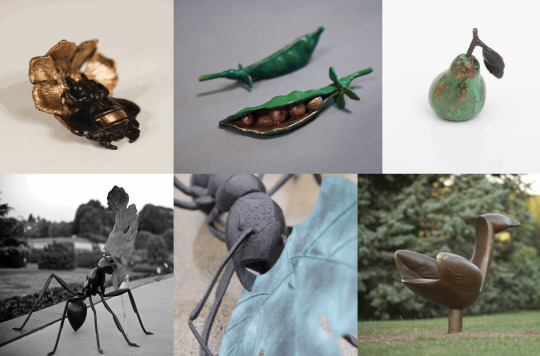
Auckland-based sculptor Samantha Lissette Her art merges organic and manufactured ideas to reveal a natural connection between "planned" natural elements and man's adaptation of them. Her sculptures sometimes use comedy or sarcasm to explore the human condition and add fun and delicacy to a material known for its weight and solidity.
Samantha displays in New Zealand and abroad. New Zealand and China hold her work. Lissette has received public and business commissions for her bronze work, from monuments to miniatures.

Object of Devotion by Jim Wheeler
His sculptures contemplate nature and show how humans are part of it. Macrocosm contains microcosm. Finding human nature in nature is his spiritual practise in sculpting. He illustrates the interdependence of all living beings and their environment. Nature is our most perfect system and should inspire our society.
A modest sculpture of a tree's life cycle in your hand conveys a broader truth.
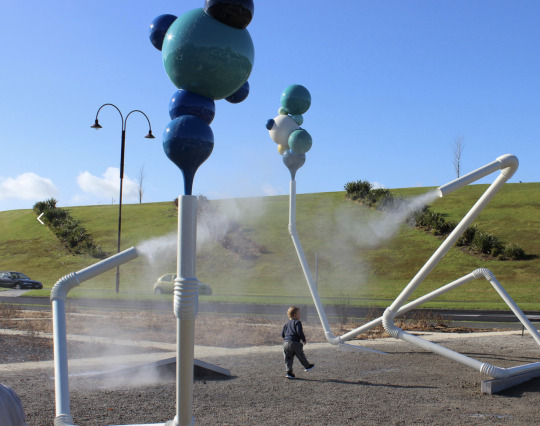
Upon a Pond by artist Seung Yul Oh at Albany Stadium Pool.
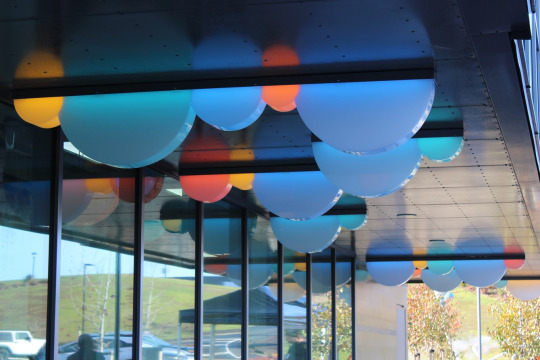
Drop a Loop by artist Seung Yul Oh at Albany Stadium Pool.
Upon a Pond and Drop a Loop combine Oh's humour, brilliant colours, and interaction with pool enjoyment, water, and playfulness. They exhibit swimming pool water in its various phases and make art part of everyday life.
Upon a Pond literally vents! Oh, and designer John O'Sullivan's enormous, colourful sculpture, inspired by blowing bubbles with bendy straws, adds surprise and amusement to the pool facility's outside.
Eye-catching Drop a Loop has 11 cloud-shaped light boxes near the pool entrance. They change colour with natural light.
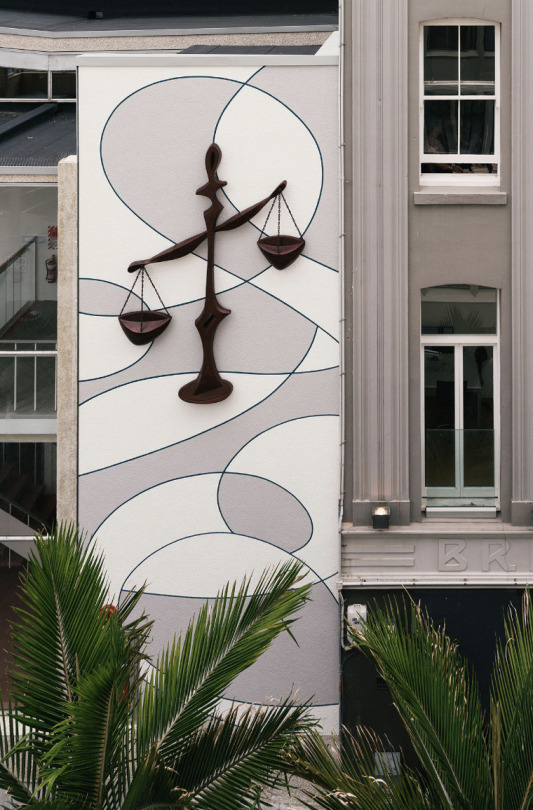
Justice by Lisa Reihana
Lisa Reihana's Justice covers the Ellen Melville Centre's O'Connell Street wall. Ellen Melville, legislator, women's champion, lawyer, and pioneer, inspired a bronze scales of justice sculpture. The bronze shape floats above a 1950s-style abstract wall artwork.
This copper sculpture serves as the focal point of the front; it's a powerful, one-of-a-kind design with a delicate curve, while the lovely abstract wall composition has a 1950s feel, drawing inspiration from James Turkington's painting of the Parnell Baths. To honour Ellen Melville.
0 notes
Text

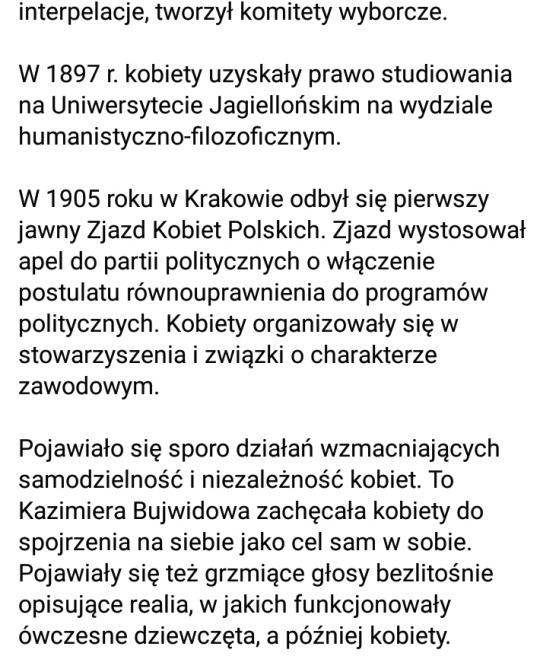

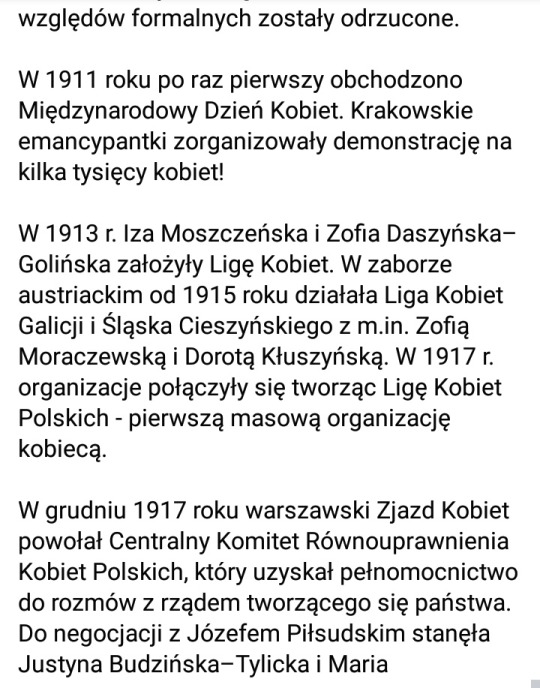

Decided to upload deputy Marcelina Zawisza's Facebook post about today's important date, 102. anniversary of polish women winning the fight for voting right. We rarely speak about suffragettes from countries another than UK or US so let me change it.
Here's translation I made so it may be really grammatically incorrect. I will give Wikipedia link to every surname possible:
102. anniversary of polish women winning voting rights.
Contrary to description we can find, voting rights were not given out to polish women. Voting rights had to be fought over. Stamped-out in front of marshall Józef Piłsudski's house and if it was needed, tapped-out with umbrellas at windows of his residence, screamed-out at rallies. But from the beginning...
In 1891 suffragettes sent out first petition demanding abolishing male power of attorney in election to National Seym (government basically). Women participated in many forms of manifestation of their demands: protests and rallies, writing interpellations, organising Election Committees.
In 1897 women were allowed to study on Jagiellonian University (in Kraków) on Faculty of Humanities and Philosophy. In 1905 first Congress of Polish Women was held. Congress apelated to political parties to include postulates of equality. Women created and joined associations and committees of professional nature. Many actions supporting independency of women were performed. Kazimiera Bujwidowa encouraged women to view themselves as aim on itself. Voices describing unmerciful living conditions of women and girls were heard more and more. One of such voiced was activist Maria Turzyma, who wrote "Woman doesn't have free will because if she would, one day she might not want to do what they tell her to do".
In 1907, Paulina Kuczalska-Reinschmit, a hetmaness and leader of first wave of polish feminist movement created Union of Equality for Polish Women. She had no desire to convince people to agree with her, she preferred to do what she ought to do.
The same year was the first meeting of said Union, which Maria Konopnicka described as "war council".
In 1908 Maria Dulębianka carried out very brave political campaign during which she agitated for voting rights for women. As a candidate for National Seym she collected 511 votes – those were rejected for formal reasons.
1911 was the first year to celebrate International Women's Day. Suffragettes organised manifestations in Kraków. Thousands of women took part in it.
Iza Moszczeńska and Zofia Daszyńska-Golińska funded League of Women in 1913. In part of country annected by Austria, League of Galician Women and League of Cieszyn Silesian Women functioned since 1915 with Zofia Moraczewska and Dorota Kłuszyńska as members. In 1917 those two leagues were connected becoming a League of Polish Women – first mass organisation of women.
December 1917 was the month of Warsaw Union of Women funded Central Committee of Equality for Polish Women which had the power of attorney to talk with the government. Justyna Budzińska-Tylicka and Maria Chmieleńska were chosen to talk with Józef Piłsudski. Effect of these discussion but also political situation that forced the government to take the most profitable decision, on 28th November 1918 Head of State Józef Piłsudski signed a decree in which was written: "A voter is every citizen of country, no matter their gender, who is over 21 years old".
Women finally could vote and be candidates – with their husband's permission.
Marcelina Zawisza together with Iwona Gałązka will create an educational series about female revolutionists to which I'm looking forward.
I have to admit translating all of these names of unions and committees really exhausted me 🤣 So I hope it's understandable but I will probably update this post a lot to correct all the mistakes.
#poland#polska#feminism#feminismo#polish suffragettes#suffragettes#19th century#20th century#history
12 notes
·
View notes
Photo

Market Street, Manchester.
#lick n polish#blinding#family PJ sets#PJ and Duncan#giving the Prime Minister shit#the sick disgusting bastard#window dressing#eyeball#polishing#elbow grease#suffragette city#Christmas#Manchester#street photography#everybody street#anyone still on tumblr?#hello?
10 notes
·
View notes
Photo
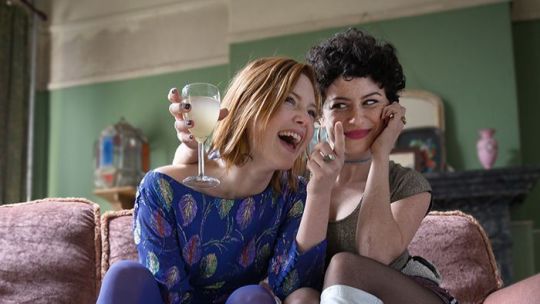


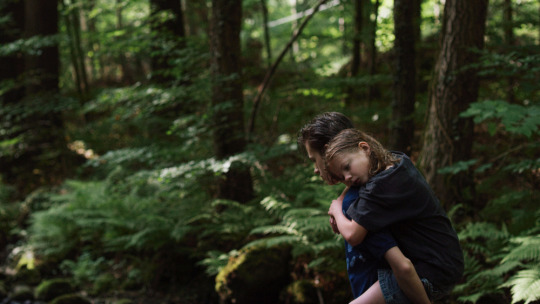



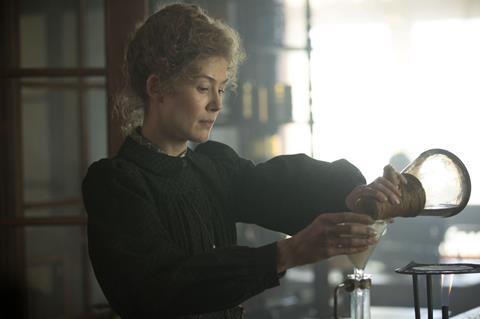
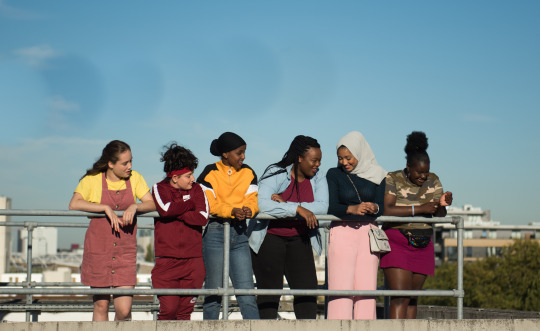
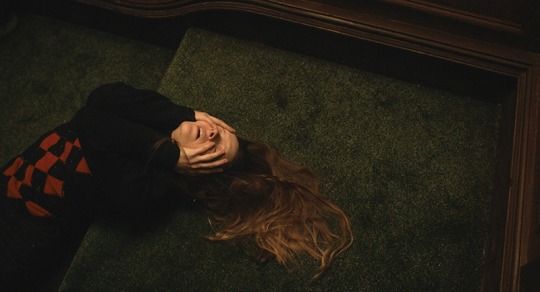
10 Most Anticipated Holdovers of 2020
Ten films that played at festivals or were released in their home countries in 2019 I can’t wait to see in 2020.
Animals dir. Sophie Hyde
Female friendship movies are my absolute favourite. An adaptation of Emma Jane Unsworth’s fantastic book about two hard-partying best friends whose lifestyle is starting to tip from fun into alcoholism Animals played at Sundance 2019 and already opened in the UK, but no North American release date yet, alas.
An Easy Girl dir. Rebecca Zlotowski
I’ve been a fan of Zlotowski since her debut film Dear Prudence. An Easy Girl has Zlotowski taking a look at the dark side of the Cannes Film Festival. The film follows a teenager who becomes entranced with the lifestyle of her older cousin who secretly works as a prostitute and helps introduce her to her wealthy older patrons. The film played out of competition at Cannes and won an award there.
Flatland dir. Jenna Cato Bass
Bass is a rising star in South African cinema and also co-wrote the Kenyan lesbian romance Rafiki. Flatland is a modern western about a policewoman who returns to her childhood home to solve a murder caused by a shy woman now on the run with her pregnant friend.
I Was at Home, But… dir. Angela Schanelec
Schanelec became only the 4th woman ever to win Best Director at the Berlin Film Festival for this film which makes it intriguing enough to me on its own. The plot is about a young girl who goes missing and then abruptly reappears and I’ve heard extremely devise reviews from people calling it a masterpiece and others calling it pretentious garbage. Can’t wait to make up my mind which it is for myself.
Jezebel dir. Numa Perrier
The film was plucked from obscurity by Ava DuVernay’s distribution company ARRAY which promotes indies directed by women and men of colour. Jezebel follows a young woman who spends the last days of her mother’s life forging a new path as a sex phone operator. Reviews have been great. Can’t wait to watch.
Portrait of a Lady on Fire dir. Céline Sciamma
Okay, so maybe this is technically a 2019 release. After premiering at Cannes the film received a token release in North America for Oscar qualification (it was completely shut out, boo). However Neon is holding out on a wider roll out until February 2020. And while I’ve seen it already I can’t wait to bask in the film, so clearly Sciamma’s best work to date, once more.
Proxima dir. Alice Winocour
I’ve been so intrigued by Winocour ever since her weird, darkly sexy, historical romance Augustine (she also co-wrote the 2015 film Mustang). In Proxima she examines an astronaut’s decision to leave her daughter behind for a year as she pursues a space mission. Space, motherhood and Eva Green? Sign me up.
Radioactive dir. Marjane Satrapi
Satrapi (yes, that Marjane Satrapi) tackles the life of Polish-French scientist Marie Curie which Rosamund Pike playing Curie. I’m not always a fan of biopics but Satrapi has an intriguing eye and the cast (including Anya Taylor-Joy and Same Riley) is pretty fab.
Rocks dir. Sarah Gavron
I enjoyed Gavron’s beautiful look at the fight for suffrage in the UK (the aptly titled Suffragette). And I’ve heard nothing but good things about her latest film, Rocks, about a teenager (nicknamed Rocks) who suddenly finds herself in charge of herself and her younger brother after being abandoned by her parents. This wasn’t on my radar until several people recommended it to me, and when that many people start talking about a film I pay attention.
Saint Maud dir. Rose Glass
I am a scaredy cat when it comes to horror films, but the reviews for Saint Maud are so promising that I can’t help wanting to watch this one. A film about a pious nurse who takes things too far when trying to save the soul of her dying patient, the film also co-stars Jennifer Ehle (who is best known as Elizabeth Bennet in the ‘95 adaptation of Pride & Prejudice). Ehle is a lovely warm presence in every film she’s a part of and maybe one of the most underrated actresses of all time imo. Is Saint Maud the movie that will bring her more widespread recognition? I hope so!
#lists#most anticipated#Animals#Sophie Hyde#An Easy Girl#Rebecca Zlotowski#Flatland#Jenna Cato Bass#Angela Schanelec#i was at home but#Jezebel#Numa Perrier#Portrait of a Lady on Fire#Céline Sciamma#Proxima#Alice Winocour#Radioactive#Marjane Satrapi#Rocks#Sarah Gavron#Saint Maud#Rose Glass#52 films by women#female filmmakers#women directors
2K notes
·
View notes
Text
Epilogue: Underwater (SC Titanic, Zetta x Adele Series)
As promised, here the epilogue of the Zetta x Adele Series, folks.
This is the very end of a project that meant me quite a lot to me and got me through the last terrible year. Thanks to all those who supported it: hope you enjoyed it and will enjoy this ending.
In case you were wondering, this song inspired the whole series, particularly the last chapters:
youtube
I will skip the tag list for once since it’s pointless anyway.
➡️ Ch. 1, Ch. 2/1, Ch. 2/2, Ch. 3, Ch. 4, Ch. 5, Ch. 6, Ch. 7, Ch. 8/1, Ch. 8/2, Ch. 9, Ch. 10/1, Ch. 10/2, Ch. 11/1, Ch. 11/2, Ch. 12, Ch. 13, Ch. 14, Ch. 15 , Ch. 16, Ch. 17
_________________________
Almost a century after the sinking of the RMS Titanic and to celebrate Canada becoming the first country outside Europe to legalise same-sex marriage, the Canadian Film Institute decided to work side by side with several LGBTQ+ organisations across the world to put together an exhibition focused on the early queer cinema and the many queer stars who were forced to hide their true selves in the Golden Age of cinematography, spanning from 1890s till the aftermath of Second World War. "A testament to the role the LGBTQ+ community played in the history of cinema and that we have always been here, even if people hardly saw us" as a journalist wrote on a queer magazine.
After the recent discovery of some private documents, the curators were overjoyed to include an icon of the 1900s - 1910s cinema like Zetta Serda into the retrospective and cast a new light on her extraordinary career sadly soon forgotten after the advent of the sound era. Yet, the silent picture star was mentioned as a model and 'endless source of inspiration" by many queer movie stars like Cary Grant, Katherine Hepburn, Greta Garbo all part of the retrospective. Rumor has it that as soon as she landed in America, Marlene Dietrich demanded his agent a meeting with Mrs King.
A curator drove all the way to Montreal to meet the last known heir, a certain Mrs. Julia Nowak, who greeted him on the threshold of a cosy downtown apartment. She offered him a coffee and a slice of a Polish sweet bread: the recipe was a family heirloom, she explained, beaming. She was in her late fifties, a therapist, she said. Her hazel eyes gleamed when she added, in a pleasantly soothing voice that betrayed a hint of excitement:
"I must confess I am so incredibly happy that you contacted me about the retrospective. I adore the idea and I will make sure to attend it. Also" she nodded to a wedding picture hung to the wall "did you know that my wife is in politics? She campaigned for the legalisation...yes, Madeleine Fournier: see, you know her! We got married right after the law passed. If anything, your call and project made me twice as happy".
She took a pause, smiling over her coffee in remembrance.
"Anyway, back to the matter of your visit...yes, as far as I know, I am Zetta's last heir. As you probably know, my family wasn't officially related to her but she stated otherwise in her will".
She moved to the couch and gestured the curator to follow her as she opened up one of the boxes and chests piled into the living room and picked out an old album, the leather cover worn at the edges. Dust waltzed in the air as she opened it with caution and gentle care. She showed him a slightly discoloured black and white picture of a young couple kissing for the camera in front of a church. Another wedding picture, from a different era.
"Nana Hileni and Papa Maciej's wedding picture. I still remember them even if they both died when I was barely a teen...as if one couldn't bear to live without the other. Or so I like to think. She would help me with the homework, mathematics particularly, and he baked this bread for me till he was too weak to do so. He always claimed that he won Nana's heart with his pastries but she always denied it laughing".
She passed another picture of the same couple proudly standing in front of the Nowak family bakery in Hoboken.
"Frankly, I believe that Papa's broad shoulders and Marlon Brando smile are more likely to blame for this coup de foudre" she laughed. "And he knew how to deal with her no-nonsense attitude and vice versa. They...balanced each other, if you wish".
She picked another picture and handed it to him. A woman was looking down in tender adoration and awe to a baby nestled in her arms looking up at her, outstretching a tiny arm in an attempt to touch her face.
"There! This is Dad" she pointed at the baby before turning the picture where someone wrote 'Alex meets Auntie Adele'. Turning it again, she pointed at the woman.
"This is Adele Carrem. Or Auntie Adele as I've always heard calling her. Nana's sister and Zetta's publicist and companion"
Putting it back into the album, she carefully picked a bunch of other old pictures.
"You surely know who this one is" she smiled, handing out the one on top.
The photo was rather grainy but you could still recognise the same kid, slightly older, around two, sucking his thumb, cuddled up in Zetta's lap. The actress had aged a little but her features were unmistakable and it was endearing to see her sitting by the fireplace to read that kid with the sleepy face a bedtime story.
"Sadly, I have never met them. I wish I did, oh you have no idea...but stories of them lived through in our family" Julia continued. "My Dad loved his Aunties - as he called them - dearly and by what I've heard and read, they loved him in manner as if he was their own. He knew little of them or Zetta's career back then...to him they were just the sweet ladies who would buy him ice-cream in Central Park or take him to see his favourite pictures over and over again at the movie theater. He said he will never forget the afternoons he used to spend with them in a Manhattan cafe that no longer exists around Christmas: Nana and Papa worked like crazy as the festive season approached and the glorious cup of hot chocolate with an elegant puff of cream on top with the Aunties became a tradition to him. He kept it alive somehow as he did the same with me".
She handed the curator a bunch of other pictures: Zetta cleaning up Alex's face smeared with jam, the both of them laughing; Zetta posing with Maciej and her Dad at a table in the Hoboken bakery. He eventually mirrored her smile seeing a five years old Alex at the beach all engrossed in building a sandcastle with Hileni and Adele, and he standing at the water edge hand in hand with Miss Carrem, looking out into the distance.
"These are family pictures. I'll show you the Zetta's private memorabilia we cherished".
Julia searched a little, opening an old chest and handling every item inside with tender care. When she found what she was looking for, she showed the curator an elegant set of smaller boxes containing letters, dried flowers and photos.
"I have already received an offer to get these published. I'm still pondering it. Before agreeing, I want to consider throughly if this is a thing they would have wanted, even if they're no longer here"
The curator nodded as she kept searching. He skimmed a few letters and smiled as his eyes fall on the photos hidden away in those boxes: the two women sitting together and chatting at Hileni's wedding, Zetta's reading a script, lazily sprawled on a chaise long in her apartment. Some had short lines handwritten on the back, like a promotional picture with "Missing you" written by Zetta herself. The curator showed another to Mrs Nowak: a visibly excited Miss Carrem proudly showing to the camera a document announcing her voter registration. On the back, in Zetta's penmanship: "On the way to vote...my sweet Adele won!".
"Oh you didn't know? Auntie Adele was a suffragette! I couldn't believe it when I first heard it! Nana told me that she was in and out jail when they lived in London because of protests. You know, like those suffragettes you read about in history books but less famous. Yet she fought for women's rights and kept fighting for them even in America. She was quite disappointed though by some major decisions of some feminist movements and eventually joined a socialist Union 'more rightfully welcoming working class individuals, immigrants and black brothers and sisters'. It's all in those letters but yeah, you couldn't possibly know. So little is known about her outside family".
A little smile drew on her face as she put back the photo.
"That photo was taken the day of the first election open to women. I checked the date. I suppose Zetta wanted to immortalise the moment...it was sweet of her, huh? Auntie Adele must have been so proud and overjoyed that day! You know, my Dad was born in 1920 when women's right to vote was legalised nationally and Nana once told me that Auntie commented the lucky coincidence saying she was incredibly happy her nephew would get to live in a fairer world. She was a true force of nature...she never talked much of the sinking of the Titanic just like Zetta and Nana actually but when one day Dad asked...he was barely a child and probably found an old article about the tragedy...Auntie Adele minimised but Nana assured him that her sister saved her life that night, risking her own to go down to the belly of the sinking ship to bring her to safety. Auntie simply shrugged, saying that it was what sisters do and that they made it to the lifeboats only thanks to Zetta, who shouted protests to stubborn officers and eventually found them a spot on a boat. I cannot even bring myself to imagine how scary that must have been: I cried so much when Madeleine took me to see Leo and Kate...to think they were there and it was all real!"
She picked a few other objects out the box: a Shakespeare Sonnets book in a leather cover with golden engravings, with a little handwritten dedication 'To Adele, my sonnet 116. Happy birthday! With all my love, Zetta'; old scripts with annotations, a framed photograph of Adele and Zetta slow dancing barefoot in the living room of a gorgeous Long Island mansion.
"These have a sentimental value" Mrs Nowak noted, her voice betraying the flicker of emotions as she picked it up.
She took a deep sigh and continued.
"I remember the day I told Dad I was gay as it was yesterday. We had always been quite close so it came natural to tell him first. We were in his car, he had come straight from college to pick me up at ice-skating practice. I..I dropped it in the middle of a conversation, bracing myself for the worst. I heard so many bad stories about coming out to your parents I was terrified of the consequences but I couldn't hide it anymore. I mean, yes, in public: bullies get even nastier if they know and I didn't want people shouting me "dyke" at school. But I needed to get it out of my chest...with someone at least. He kept quiet for a moment and I felt like drowning in shame. But then he spoke".
A nostalgic tender smile formed Julia's lips.
"He said he had two amazing Aunties that contributed to make his life a wondrous adventure. It was thanks to them that he, the son of a baker, could attend a prestigious college, for instance: they offered to pay for it without asking a penny back. They also helped him write his first romantic letter to his childhood sweetheart and consoled him when the little girl turned him down. But his Aunties had a secret, he added. He said: to my kid eyes they were no less a couple than Mom and Dad and at home we all treated them in manner but one day Mom made me promise to behave differently when we were in public. In public I would refer to her sister as 'Auntie Adele' but call Zetta by her name. He didn't get it and it took some getting used to. He soon noticed that even the Aunties behaved a bit differently out in the sun: they wouldn't hold hands or use endearing words in the street or when other people were around. They simply behaved like good friends did. He understood it later when he, as stubborn as a mule, asked them directly".
Julia gently grazed her fingers on the glass of the framed photograph, caressing it.
"And they told me everything, he said. That they were in love, just like mom and dad were, but people out there could be uncomfortable and extremely rude to women loving other women and men loving other men. That they kept their companionship a secret in public because those people had no problems with women being friends and they didn't want to have bad words or worse happening to them. I remember asking him what he thought about it. He smiled. 'I cried. Since Auntie Zetta mentioned people claiming that women like them were sick and would burn in hell, I actually started crying. I sobbed desperately in her arms, crying that I didn't want them to burn in hell, I loved my Aunties and I was happy they loved each other. Eventually they explained me it was just a vile lie spread my malignant people. But I got quite a scare and kept staring at them with puffy red eyes and my face wet with tears for a while. It required lots of cuddling to bring a smile back on my face'. He shook his head, laughing of his endearing naivety. Then he pulled over and looked at me. He continued: 'I still don't get why people keep spreading those mean lies but I know for sure that my Aunties weren't sick and didn't end up in hell and so won't you. Don't believe bullshits like that for a split second, okay? And I also want you to remember that it doesn't change a thing for me and mom too. You will always be my little girl, our little girl and we love you'. We shared a long hug before driving back home. On the way back he insisted to buy my favourite chicken and waffles for dinner, saying mom's veggie soup could wait. For my birthday, a month later or so, he asked me to follow him to the attic and showed me this chest. To meet the Aunties that 'would have surely been there for me'".
She tipped away a tear.
"I told you I married Madeleine right after the legalisation of same-sex marriages. My wedding was also the last public event Mom and Dad attended together before his health worsened irremediably. He passed away last year".
For a moment she looked on the verge of tears but she recovered quickly.
"Sorry...anyway, that day Dad insisted on walking me down the aisle even if he was getting weak. He beamed with pride when a friend fixed a rainbow ribbon to his jacket. Later at the lunch he read a speech he had written for the day, his hand shaking. He shared the story of his Aunties. He said that despite the hardships their situation forced upon them, they had quite a happy life together, a happiness carefully hidden from the world. He wished us to find something similar to what they shared without needing to hide anymore. He said Adele and Zetta would have been so happy and proud to celebrate with all of us that day"
Mrs. Nowak picked the Shakespeare Sonnet book and gave him a fond look.
"He brought this to the wedding. And he read for us the sonnet 116, the one Zetta mentioned in her dedication. You know, the one that starts with 'Let me not to the marriage of true minds admit impediments..."
-----------------------
A few months later the exhibition on old Hollywood queer cinema and artists opened. Each artist had a room that soon filled with a crowd of enthusiastic visitors.
In the first half, in a room arranged as a turn of the century nickelodeon with velvet chairs, all the memorabilia of Zetta Serda's public life: panels explaining the various stages of her career and the birth of her myth, promotional pictures of her performances, articles about her and a copy of a gazette announcing her wedding with the director Richard King. On the wall, on a screen her entire filmography rolled up in loop, bewitching spectators after a century. In display cases: the gorgeous sapphire necklace she wore on her last night on the Ship of Dreams and at the movie party of Surviving the Titanic, and a replica of her Cleopatra costume. The aging Queen of Egypt with a tragic love and destiny immortalised by Shakespeare was her last role back on the theater stage before retiring from the scenes. Old scripts with her personal annotation were displayed with photographs taken on sets and mundane events.
The wall hosting the motion-picture screen cut the room in half. On the other side, the hidden half of her life. Her life with Adele no one suspected back then. A life kept secret that now unveiled in front of the eyes of the visitors.
The curators discovered that finding public pictures of Miss Carrem was nearly impossible, true to the nickname she acquired as time went by: The Shadow. She stayed at Zetta's side until and even after she stopped acting, showing rare loyalty and devotion, but ever surrounded by this mystery allure. No one, even the most stubborn reporters managed to know anything about her and she was soon dismissed as a Titanic survivor, possibly a fan, who worked as Zetta's secretary and somehow gained her respect. Little they knew about the depth of their relationship and what stacks of secret letters and family memories revealed of the life of Miss Carrem. A panel finally told her story and her secret achievements: Adele, or better Adal, kept fighting for a fairer world and society her whole life and marched for women's right to vote on the famous parade in 1915. She also passed the teaching of Edith Garrud to her American sisters.
The only pictures of her came from the Nowak family, except for one. The only photograph of a public appearance of Miss Carrem as well as the only known public appearance of Zetta and Adele. An old grainy photo accurately framed showed Adele shaking hands with The Unsinkable Molly Brown on a podium. In her free hand a shiny medal and a few steps behind the mayor of New York.
According to the panel, the survivors' committee founded by Mrs. Brown decided to award Miss Carrem a medal for bravery and a generous check "to help her and her sister starting a new life in America". With great surprise, Miss Carrem received the medal and the check, thanked the board but refused the honors. Instead, she asked to deliver them both to the family of a certain Charlie Stoke, a stewart that lost his life in the sinking to save her life and those of many passengers. She added that her friend expressed the desire to study naval engineering one day and she wished that the money kindly offered to her would be enough to establish a scholarship for boys like him across the ocean. In another picture, Miss Carrem and her sister chatted with Moll Brown in company of Zetta. Eventually, other philanthropists and wealthy socialites signed checks for her cause so that the Stoke family received a generous contribution too. And today, as another picture confirmed, the faculty of naval engineering of the University of Newcastle hosts a marble engraving of Charlie Stoke: to his memory a scholarship had been instituted one year after on the anniversary of the sinking. Since 1913 it has been helping students of poor background to get an education and improve their life.
Zetta herself became a philanthropist during her Renaissance and ever since. The first act of her new phase of her life was joining the Moll Brown survivors committee to provide help to the second and third class passengers families and survivors. Some said that the tragedy she witnessed touched her heart, other claimed that it was to be attributed to the influence of her publicist. Jokingly, she used to say that after all, she had too much money yet all she could have wished for in her life, so why not doing some good with it? A considerable donation under her and Mr King was received by the main hospital during the Spanish flu pandemic; she was particularly active in providing financial help to struggling neighbourhoods and female education institutions.
In the middle of the room, a long glass display hosted the Shakespeare Sonnets opened at sonnet 116 and a selection of the private correspondence between Zetta and Adele.
My darling,
You will receive this letter tomorrow morning when I'll be already off to Chicago. The suitcases are ready and packed, this is a goodnight note scribbled the night before leaving you to remind you how much I love you and care about you. How much I'm going to miss you even if - thank God! - we won't be parted for long...
Do not forget you promised me to write every day! Write to me, Adele, write to me whatever thought crosses that gorgeous mind of you: you know I could you rambling for hours without getting tired of the sound of your voice, of your sparkling wisdom. I wanna know everything. So don't be shy: I'll be waiting your letters with tender impatience.
Can't wait to be in your arms once more.
Adoringly yours,
Zetta
-
Dear, dearest Zetta,
I went to Central Park today with Hileni. It was a gorgeous spring day, sunny, a gentle breeze blowing: 'simply too beautiful to be wasted inside' as my sister put it. Did I tell you that she's still exchanging letters with the delivery boy from the hat shop? I thought they were over but apparently he invited her to the nickelodeon next week.
Anyway, walking in the park with her I suddenly realised how I wanted to share that spring wonder with you.
When are you coming back to New York? Tell me soon, please. And even 'soon' won't be soon enough: you're always on my mind since you left. But yes, tell me soon so I can make you promise we will go for a walk before the weather becomes too hot.
Do you think I can wrap my arm with yours? Is it professional enough for a publicist? Even just for a few steps: oh you have no idea how I would love that! Or maybe you have? I hope so: it'd mean you miss me as much as I miss you when we are apart.
Oh, I almost forgot: all settled with that magazine you mentioned before your departure! I negotiated a two pages long interview, plus pictures. And a cover mention.
Hope I did well: you have already fired me as your secretary, I must prove you I am just what you're looking for in a publicist...
Can't wait to see you again!
Loving you always,
Adele
Only one letter was copied on a panel of its own on the main wall side by side with a blow-up of the picture of Adele and Zetta slow-dancing barefoot and free, for a blessed moment immortalised in a discreet shot. Adele pressing a tender kiss on Zetta's forehead, drawing a soft smile on the acrtress' lips. Many visitors commented it was heartwarming to see such a photograph that conveyed the intimacy and the warmth of affection radiating from the dancing couple. Some said that Zetta was even more beautiful like that: free, hair slightly askew and genuinely happy, loved.
What stole their hearts away though was the letter attached to it. It was no surprise that the curators decided to name the retrospective Underwater.
Dearest Adele,
Forgive me for the tone of this letter. I am writing it down in bed while I cannot sleep and my mind runs back to you as if we could meet halfway between the miles separating us, in a world of fantasy of our own.
It's ridiculous how much I miss you! I want you near, I need you near all the time. Take tonight: if you were here with me, I would be heavenly sleeping in your loving embrace. Most unfortunately, you are not and I'm lying here, insomniac, thinking of you. And about my life.
No, don't frown. I am not getting all sad again. It's...bittersweet. And - I'll spoil you the ending so you will stop worrying, hopefully - it gets better the more you proceed.
Have you ever felt trapped underwater? I did, my whole life. Always hiding, always measuring words, gestures, gazes not to let them see, not to let them know...so little time to go up and break the surface. Drop the mask and breathe. In, out. Once, twice. In my lowest moments I repeated to my myself: how are you gonna survive?
One day an acquaintance with a remarkable passion for the sea explained me and the other bored commensals that you can keep someone alive by breathing oxygen into their mouth underwater. Pretty much like mouth-to-mouth resuscitation helps an unconscious person to regain consciousness. I found it interesting but doubted his words.
Then I met you, Adele. My dearest, wondrous Adele. And I learnt that yes, you can't breathe if you're constantly underwater...but you won't drown if you have the right person swimming by your side in those deep waters.
Put your lips on me, Adele. Touch me, hold me in your arms. And I can live underwater.
With your love, I can live underwater.
We can live underwater.
I love you.
I want to cover a full page of these three simple words: I love you.
I want to cry them out and entrust them to the winds, to the night.
But what for? Who cares if the world knows or not?
I'll whisper them over your lips when we will be reunited.
So you can breathe underwater.
Counting down the hours separating us, my love.
Eternally yours,
Zetta
35 notes
·
View notes
Note
Halp! I read Crooked Kingdom and Spinning Silver in the same week. Is there any point in reading any other book ever again?!?!?!?!?!?!!!?!!! (Genuinely open to recommendations.) I am bereft at having finished them, and wondering how soon is too soon to reread Spinning Silver...
lmao god that’s a mood. I mean those are very much my two of my favorites, but of course I have recommendations.
Spinning Silver has a “mirror” novel called Uprooted that explores Naomi Novik’s polish roots and fairytale; it’s a twist on the classic girl gets sacrificed to be locked in a tower by a “dragon” but with wizards and a sick wood.
As for the grishaverse, I don’t know if you’ve already read the grisha trilogy or the Nikolai duology, but I certainly recommend King of Scars at the very least. Nina’s in it and Nikolai and Zoya are two of the best grisha trilogy characters (along with Genya, Tolya, and Tamar who are all also here). I haven’t about to read Rule of Wolves but I haven’t yet. Now the grisha trilogy is disappointing in general, but especially in comparison to Crooked Kingdom, Bardugo’s best novel, in my opinion. However, it’s also not quite as bad as everyone says. The worldbuilding established here is pretty cool, the politics in seige and storm are really fun, and there are really cool characters in it, even if the main protagonist… well. Alina’s not actually a boring or awful of a protagonist, or at least she has the opportunity not to be. She’s incredibly selfish to the point of moral ambiguity, and she’s terribly funny and combative. However, and this is my main issue with these books, she is very much punished by the narrative anytime she seeks agency or power or really does anything interesting, which leaves us with our magical girl chosen one just sort of passively shoved around the board.
Bardugo also wrote Ninth house, which I highly recommend. It’s an adult novel, so the violence -and there is a lot of it- tends to be described and gory and there’s a lot of talk about drug abuse so keep that in mind (plus the main character being abused and her best friend being killed/raped/drugged) so keep that in mind. The main protagonist is really interesting, and features Bardugo’s usual moral greyness. She’s angry, she can see ghosts, she’s traumatised, she has a terrible secret, and she does all of her fighting for abused women. The book has a lot of commentary on classism and elitism, as one should expect from a book about an impoverished women attending an ivy league with dangerous, poorly run, magical societies in it. The worldbuilding is a treat, but expect a lot of ghosts and a lot of rituals.
If you’re looking for more fantasy novels with fairytale vibes/retellings and strong female characters, that’s one of my favorite genres, so I have a few. I’m terribly fond of A Creature of Moonlight, which features a moving wood, a dragon’s daughter, royal court politics, and an uberindependent protagonist. The Cruel Prince is the only faerie book that counts along with the rest of Holly Black’s works, and if you’re looking for more enemies to lovers, you are in luck. The main reasons to read this book, though, is the political intrigue and the murder happy main character. The Once and Future Witches is a take on the suffragette period and witch fairytales. It’s not necessarily my favourite nor do I think it has the makings to be anyone’s favorite, really, but I do recommend it if only for the fairytale retellings and historical elements. Howl’s Moving Castle is an absolute delight, with lots of fun, bickering, main characters, and a very fairytale take on the magic system. I need to read Deathless so bad, but I haven’t gotten around to it yet. I hear only great things about the retelling of the Russian fairytale, though, so I’ll go ahead and recommend it.
Revenge stories are also a favourite of mine, so if you want more of those, my main recommendations are The Count of Monte Cristo and Vicious. The Count of Monte Cristo features our antihero being wrongfully imprisoned due to the machinations of three people. After escaping and getting rich beyond his wildest imagination, Edmound seeks to utterly ruin all three of them, destroying a lot of innocent lives in the process, rethinking the ethics of his revenge plan a lot, and a lot of claiming he’s sold his soul to become Providence. The main drawback is that the novel deals handedly in Orientalism( though I have a lot to say about why discussion of Orientalism is important to understanding Edmound’s character and why he is percieved the way he is by the other characters) and that it features an enslaved woman falling in love with her captor, who is also our protagonist. So yeah, grain of salt. It was written in 1844. Vicious tells us the backstory and the mainstory side by side throughout the novel, featuring two ex-best friends who experimented with killing themselves in order to gain superhero powers. When one of them lands the other one in prison and devotes his time to killing other ExtraOrdinaries, what our superheroes/more-like-supervillains-usually are called, because he likes to play god, our protagonist, the imprisoned friend, escapes for a revenge quest. Along the way he forms an incredibly clunky, adorable found family. I love this novel so much.
If you’re looking for more historical fantasy, I have some recommendations here as well. Diviners is an occult murder mystery set in the 1920s, that really really spends time putting you in the 1920s. It features a fun ensemble cast that grows with each installation, though the main main character of the first book does take a while to grow on you and there’s a boring ass love triangle. Read it for the 1920s and the ensemble cast that really takes off in the second book. The Poppy War is based on the Second Sino-Japanese War with a very enthralling magic system, and a main character who takes moral greyness to whole new heights. It has a laundry list of trigger warnings you need to read before you pick up the book, but the two most important things to understand before getting into it is that there’s a section based on the Rape of Nanjing, which does not pull its punches and the first book ends with our protagonist committing magical genocide on an entire country. In general, this book absolutely refuses to pull its punches and that’s my number one reason for recommending it. London Calling is an exploration of fatherhood with themes on family and catholicism that features time traveling to the London blitz. It’s barely fantasy, and it’s again not a favorite nor will it become yours, but it’s very moving.
Also, this is more of a general recommendation, but I highly recommend Gideon the Ninth. “Necromancer Lesbians explore a haunted gothic castle in space.” What more do you need to hear? Our main character is a snarky butch swordswoman in the first book and the second book is her goth depressed over-achiever enemy turned sort of girlfriend turned mind pal. The fun villain behavior is off the chart, the worldbuilding is immaculate (there’s an in-universe essay in the back that finishes with someone’s snarky graffiti), and it’s funny as hell. The book is about necromancers so the gory descriptions of dead bodies is very much not for the faint of heart. Keep that in mind.
7 notes
·
View notes
Photo


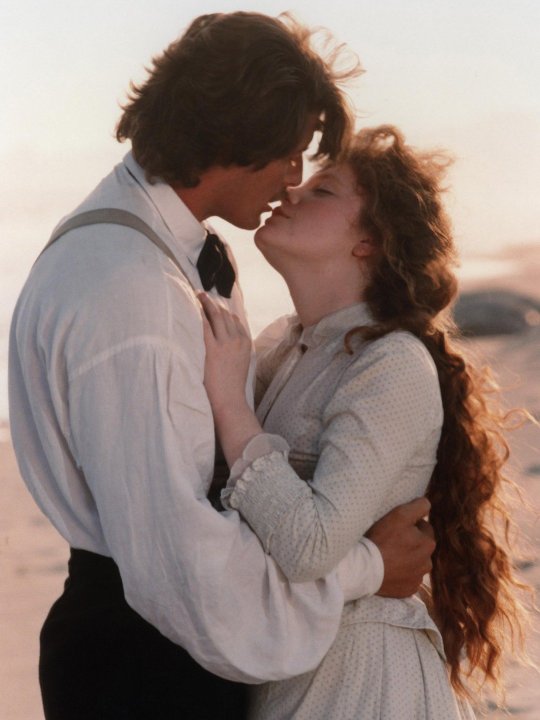
A bored lawyer and a suffragette vie for the attention of a faith healer’s charismatic daughter.
I don’t know what I need to do for you all to watch The Bostonians (James Ivory, 1984) but please do yourself a favor and watch it. It’s too terrible when certain films are forgotten, and left to obscurity.
I feel the anguish and despair portrayed brilliantly by Vanessa Redgrave in Olive Chancellor’s character is enough a reason to watch the film but there’s other things to like too.
For one, the drama, is so compelling like. Henry James is a special one, it’s based on his novel (which at some point i’d need to get myself a copy of). Characterization and conflict go hand in hand and in here it’s done in the most polished way ever, couldn’t be any better. The performances by Christopher Reeve and Madeleine Potter are on point, supported by Jessica Tandy and Linda Hunt.
Cinematography by Walter Lassally. Some of the shots in this film are exquisite, and I don’t mean just the color, or depth of field, you feel the intimate atmosphere throughout, the performances part of it too, of course.
Script written by Ruth Prawer Jhabvala, out of the Henry James novels she adapted I’d say this one is the best one. The changes made from the novel make sense and enhance even more the conflict.
In my head it reminds me of Thomas Hardy’s Wessex although it is not as tragic as his novels.
It’s a great film, made for debate. Been reading lots of academic articles finding new insight on it and it just blows my mind, everytime. I cannot not share it you know. If anyone needs a link, i’ll be happy to provide one.
#Vanessa Redgrave#Olive Chancellor#Madeleine Potter#Verena Tarrant#Christopher Reeve#Basil Ransom#Henry James#The Bostonians#James Ivory#Ismail Merchant#Ruth Prawer Jhabvala#Walter Lassally#film
9 notes
·
View notes
Text
10 amazing women: activists
Read introduction
Dame Millicent Garrett Fawcett GBE (June 11, 1847 – August 5, 1929)
source: The Greatest Women in History: The Remarkable Women Who Changed Our World
Was an English politician, writer and feminist. Millicent Fawcett came from a pioneering family. Her sister, Elizabeth Garrett Anderson, was Britain's first female doctor and she certainly wouldn’t be the only daughter of the family to make her mark; Millicent was inspired by her siblings fighting spirit.
Fawcett developed an interest in women's suffrage in her teens and at just 19, she was already secretary of the London Society for Women’s Suffrage. She became known as a passionate and erudite speaker and as the years passed, established a respected reputation as a supporter of suffrage. Thanks to her work as a speaker she became a member of Lectures for Ladies, an education group that originated in Cambridge and as such, in 1871 she became a co-founder of Newnham College, Cambridge, only the second college to grant entrance to women. Though Fawcett was a dedicated campaigner on behalf of women’s suffrage and was eventually appointed leader of the National Union of Women’s Suffrage Societies, she advocated only peaceful protest and activism. Fawcett looked darkly on the Women's Social and Political Union's use of direct action. She actively distanced herself from the actions of more militant suffragettes and spoke out against those who advocated what she considered extreme means to achieve their common aim.
Fawcett, however, didn‘t limit her campaigning to England. In 1901 she was appointed to head a commission of women who were sent to South Africa to report on the conditions in concentration camps where the families of Boer soldiers were being held. It was the first time a woman had been given such a responsibility and Fawcett took up the cudgels on behalf of those who were suffering in the camps, campaigning to improve conditions for the women and children who were interred there. She also regularly campaigned on behalf of her husband, Liberal MP Henry Fawcett, and became a familiar figure on the hustings in his Brighton constituency where the couple both spoke out in favour of women’s suffrage. For decades, Millicent Fawcett remained dedicated to the causes to which she had devoted her public life. She toured schools to talk to girls about suffrage and the opportunities they might enjoy and campaigned for women to have the right to be awarded degrees at Cambridge. Though her campaigns didn't always enjoy success, she became a figurehead for female education and as head of the NUWSS, played a pivotal role in securing the vote for the women of Britain. Though this side of her work culminated with the Representation of the People Act, Fawcett occupied any free time she now had by writing the biography of Josephine Butler, a forerunner in the suffrage movement.
Millicent Fawcett died in 1929 but her name lives on today in The Fawcett Society, which continues to educate young people on the story of suffrage, as well as leading campaigns for gender equality. Today her statue stands in Parliament Square, forever immortalised as the pioneering woman she was

Irena Stanisława Sendler (February 15, 1910 – May 12, 2008)
source: The Greatest Women in History: The Remarkable Women Who Changed Our World
Was a Polish humanitarian, social worker, and nurse who served in the Polish Underground Resistance during World War II in German-occupied Warsaw.
Irena Sendler used her position in the Social Welfare Department to gain access to the Warsaw ghetto. She smuggled in medication and other essentials and smuggled out babies, children and adults, spiriting them to safety under the noses of the Nazis. In 1943. Sendler was interrogated by the Gestapo. She refused to speak and escaped execution only because an associate bribed her guards. Though highly honoured in Israel and Poland, she remained virtually unknown in the West. Today she is recognised for her humanitarian efforts and was twice nominated for the Nobel Peace Prize
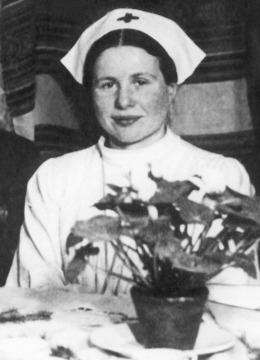
Rosa Louise McCauley Parks (February 4, 1913 – October 24, 2005)
Was an American activist in the civil rights movement best known for her pivotal role in the Montgomery bus boycott. The United States Congress has called her "the first lady of civil rights" and "the mother of the freedom movement"
On December 1, 1955, Rosa Parks boarded a bus in Montgomery, Alabama. Instead of going to the back of the bus, which was designated for African Americans, she sat in the front. When the bus started to fill up with white passengers, the bus driver asked Parks to move. She refused. Her resistance set in motion one of the largest social movements in history, the Montgomery Bus Boycott. Rosa and her husband Raymond Parks were actively fighting to end racial injustice. Together the couple worked with many social justice organizations. Eventually, Rosa was elected secretary of the Montgomery chapter of the National Association for the Advancement of Colored People (NAACP). By the time Parks boarded the bus in 1955, she was an established organizer and leader in the Civil Rights Movement in Alabama. Parks not only showed active resistance by refusing to move she also helped organize and plan the Montgomery Bus Boycott. Many have tried to diminish Parks’ role in the boycott by depicting her as a seamstress who simply did not want to move because she was tired. Parks denied the claim and years later revealed her true motivation:
“People always say that I didn’t give up my seat because I was tired, but that isn’t true. I was not tired physically, or no more tired than I usually was at the end of a working day. I was not old, although some people have an image of me as being old then. I was forty-two. No, the only tired I was, was tired of giving in.”
Parks courageous act and the subsequent Montgomery Bus Boycott led to the integration of public transportation in Montgomery. Her actions were not without consequence. She was jailed for refusing to give up her seat and lost her job for participating in the boycott. After the boycott, Parks and her husband moved to Hampton, Virginia and later permanently settled in Detroit, Michigan. Parks work proved to be invaluable in Detroit’s Civil Rights Movement. She was an active member of several organizations which worked to end inequality in the city. By 1980, after consistently giving to the movement both financially and physically Parks, now widowed, suffered from financial and health troubles. After almost being evicted from her home, local community members and churches came together to support Parks. On October 24th, 2005, at the age of 92, she died of natural causes leaving behind a rich legacy of resistance against racial discrimination and injustice

Ruth Bader Ginsburg (March 15, 1933 – September 18, 2020)
Ruth Bader Ginsburg spent a lifetime flourishing in the face of adversity before being appointed a Supreme Court justice, where she successfully fought against gender discrimination and unified the liberal block of the court. She was born Joan Ruth Bader on March 15, 1933 in Brooklyn, New York. Bader taught at Rutgers University Law School and then at Columbia University, where she became its first female tenured professor. She served as the director of the Women’s Rights Project of the American Civil Liberties Union during the 1970s, and was appointed to the U.S. Court of Appeals for the District of Columbia in 1980. Named to the U.S. Supreme Court in 1993 by President Bill Clinton, she continued to argue for gender equality in such cases as United States v. Virginia. She died September 18, 2020 due to complications from metastatic pancreas cancer.
Ruth Bader Ginsburg began her career as a justice where she left off as an advocate, fighting for women’s rights. In 1996, Ginsburg wrote the majority opinion in United States v. Virginia, holding that qualified women could not be denied admission to Virginia Military Institute. Her style in advocating from the bench matches her style from her time at the ACLU: slow but steady, and calculated. Instead of creating sweeping limitations on gender discrimination, she attacked specific areas of discrimination and violations of women’s rights one at a time, so as to send a message to the legislatures on what they can and cannot do. Her attitude is that major social change should not come from the courts, but from Congress and other legislatures. This method allows for social change to remain in Congress’ power while also receiving guidance from the court. Ginsburg does not shy away from giving pointed guidance when she feels the need. She dissented in Ledbetter v. Goodyear Tire & Rubber Co. where the plaintiff, a female worker being paid significantly less than males with her same qualifications, sued under Title VII but was denied relief under a statute of limitations issue. The facts of this case mixed her passion of federal procedure and gender discrimination. She broke with tradition and wrote a highly colloquial version of her dissent to read from the bench. She also called for Congress to undo this improper interpretation of the law in her dissent, and then worked with President Obama to pass the very first piece of legislation he signed, the Lilly Ledbetter Fair Pay Act of 2009, a copy of which hangs proudly in her office.
Until the 2018 term, Ginsburg had not missed a day of oral arguments, not even when she was undergoing chemotherapy for pancreatic cancer, after surgery for colon cancer, or the day after her husband passed away in 2010. Justice Ginsburg proved time and again that she was a force to be reckoned with, and those who doubted her capacity to effectively complete her judicial duties needed only to look at her record in oral arguments, where she was, until her death, among the most avid questioners on the bench. The Supreme Court issued a press release on September 19, 2020, regarding her death
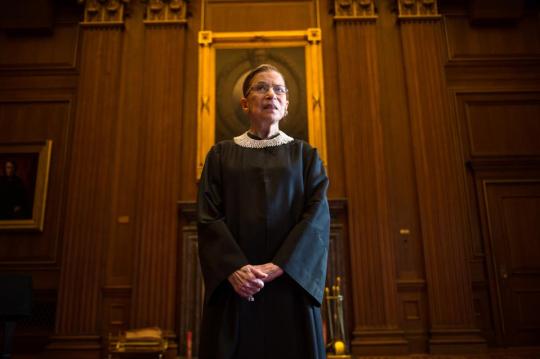
Patricia Bath (November 4, 1942 – May 30, 2019)
Dr. Patricia Era Bath was an American ophthalmologist, inventor, humanitarian, and academic. She was the inventor of laser cataract surgery. Patricia Bath was the first African American to complete a residency in ophthalmology and the first African American female doctor to receive a medical patent. She invented the Laserphaco Probe for cataract treatment in 1986. Also she became the first female faculty member in the Department of Ophthalmology at UCLA's Jules Stein Eye Institute. In 1976, Bath co-founded the American Institute for the Prevention of Blindness, which established that "eyesight is a basic human right." In 1981, Bath began working on her most well-known invention: the Laserphaco Probe (1986). Harnessing laser technology, the device created a less painful and more precise treatment of cataracts. She received a patent for the device in 1988, becoming the first African American female doctor to receive a patent for a medical purpose. She also holds patents in Japan, Canada and Europe. With her Laserphaco Probe, Bath was able to help restore the sight of individuals who had been blind for more than 30 years. In 1993, Bath retired from her position at the UCLA Medical Center and became an honorary member of its medical staff. That same year, she was named a "Howard University Pioneer in Academic Medicine." Her research showed that African-American people are more prone to eye diseases. Among her many roles in the medical field, Bath was a strong advocate of telemedicine, which uses technology to provide medical services in remote areas. For the rest of her natural, Patricia continued to work at the American Institute (which she founded) for the prevention of blindness and was involved in the restoration of vision around the world
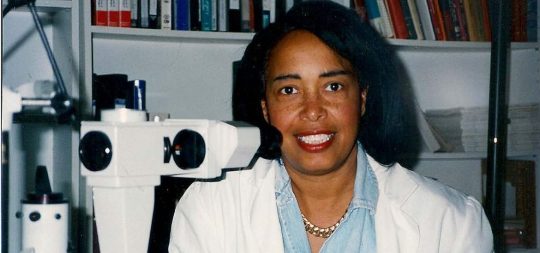
Waris Dirie (born 1965)
Waris Dirie (Somali: Waris Diiriye) is a Somali model, author, actress and human rights activist in the fight against Female Genital Mutilation (FGM). From 1997 to 2003, she was a UN special ambassador against female genital mutilation. In 2002 she founded her own organisation in Vienna, the Desert Flower Foundation.
The successful singer, writer, screenwriter, producer, actress and social activist of Somali origin Waris Dirie revealed her secret to the world: at the age of 3, she was subjected to a cruel rite of female circumcision. She shared her childhood memories with the journalist "Marie Claire" and thus for the first time tried to urge the public against this inhuman act, through which every year in early childhood mutilate (in the worst cases - kill) millions of girls.
Waris Dirie decided to devote her life to fighting an ancient and so widespread custom. She wrote her memoir (co-authored with Cathleen Miller), based on which director Sherry Hormann shot an unusually sensual and emotional motion picture - "Desert Flower" (2009). Waris Dirie became the UN Special Ambassador for Women's Rights and began active political and social international campaigning to ban female circumcision.
Thanks to Waris Dirie's public and charitable activities the governments of countries where the practice of FGM is widespread are beginning to prohibit its implementation (Egypt, Eritrea). Nowadays her foundation collects money to raise awareness about the worldwide problem of FGM and to help those affected. On 11 September 2013, Dirie as patron opened the world's first holistic medical center for the treatment and care of FGM victims in Berlin together with the Waldfriede Hospital as a cooperation hospital of the Desert Flower Foundation. The Desert Flower Cenrer was awarded the Louise Schroeder Medal by the State of Berlin in 2016. In 2014, the Desert Flower Surgical Training Center for surgeons, gynaecologists, urologists and nursing staff was established in Amsterdam together with the Desert Flower Foundation BENELUX. The Desert Flower Center Scandinavia was established in 2015 in cooperation with the Karolinska University Hospital in Stockholm. In 2017 the Centre Fleur du Desert opened with the Fondation Fleur du Desert in the women's shelter at the Hôpital Delafontaine in Paris Saint-Denis.
It’s so hard to imagine what this brave woman had to endure. But her pain became the foundation for creating something very important. She’s a great person who does a lot for our society. She, like a desert flower, is a rare and beautiful phenomenon
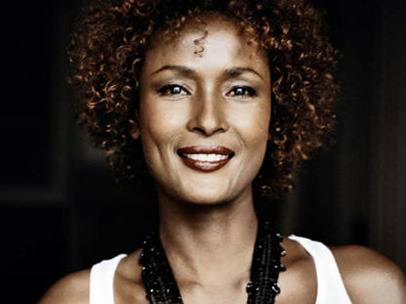
Esther Duflo, FBA (born 25 October 1972)
Is a French–American economist who is a professor of Poverty Alleviation and Development Economics at the Massachusetts Institute of Technology (MIT). She is the co-founder and co-director of the Abdul Latif Jameel Poverty Action Lab (J-PAL), which was established in 2003. She shared the 2019 Nobel Memorial Prize in Economic Sciences with Abhijit Banerjeeand and Michael Kremer, "for their experimental approach to alleviating global poverty".
Esther Duflot became the second woman in history to receive the Nobel Memorial Prize in Economics Sciences. Studying the lives of people in the poorest countries, together with her husband Abhijit Banerjeeand and colleague Michael Kremer, Duflo developed a methodology to assessment the effectiveness of the fight against global poverty through field research, which completely changed the development economics. Duflot approached the study of poverty experimentally and asked specific questions, not general ones. What happens if you give one group of the poor free textbooks and the other better nutrition? What will change? If farmers are given a 50% discount on fertilizer, will they use it? Such field research over 20 years has significantly changed the understanding of poverty. (More about this)
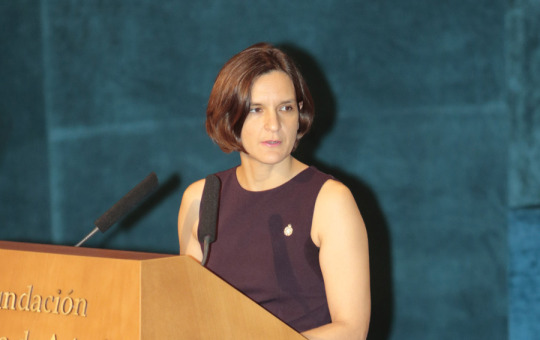
Chimamanda Ngozi Adichie (born September 15, 1977, Enugu, Nigeria)
Nigerian author whose work drew extensively on the Biafran war in Nigeria during the late 1960s.
Early in life Adichie, the fifth of six children, moved with her parents to Nsukka, Nigeria. A voracious reader from a young age, she found Things Fall Apart by novelist and fellow Igbo Chinua Achebe transformative. After studying medicine for a time in Nsukka, in 1997 she left for the United States, where she studied communication and political science at Eastern Connecticut State University (B.A., 2001). Splitting her time between Nigeria and the United States, she received a master’s degree in creative writing from Johns Hopkins University and studied African history at Yale University.
Her work has been translated into over thirty languages and has appeared in various publications, including The New Yorker, Granta, The O. Henry Prize Stories, the Financial Times, and Zoetrope. She is the author of the novels Purple Hibiscus, which won the Commonwealth Writers’ Prize and the Hurston/Wright Legacy Award; Half of a Yellow Sun, which won the Orange Prize and was a National Book Critics Circle Award Finalist and a New York Times Notable Book; and Americanah, which won the National Book Critics Circle Award and was named one of The New York Times Top Ten Best Books of 2013. Ms. Adichie is also the author of the story collection The Thing Around Your Neck.
In 2012, Adichie gave a TEDx talk entitled: "We should all be feminists", delivered at TedXEuston in London, which has been viewed more than five million times. She shared her experiences of being an African feminist, and her views on gender construction and sexuality. Adichie said that the problem with gender is that it shapes who we are. She also said: "I am angry. Gender as it functions today is a grave injustice. We should all be angry. Anger has a long history of bringing about positive change, but in addition to being angry, I'm also hopeful because I believe deeply in the ability of human beings to make and remake themselves for the better."
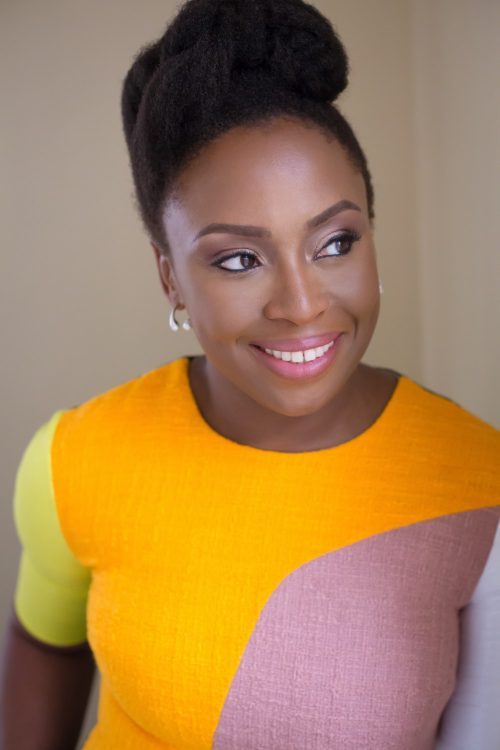
Agnes Chow Ting (born 3 December 1996)
Agnes Chow Ting (Chinese: 周庭) is a Hong Kong politician and social activist. She is a former member of the Standing Committee of Demosistō and former spokesperson of Scholarism. Her candidacy for the 2018 Hong Kong Island by-election, supported by the pro-democracy camp, was blocked by authorities, due to her party's advocacy of self-determination for Hong Kong.
Agnes Chow started fighting for democracy as a teenager and became famous at 18 years old. Supporters call her "the goddess of democracy" and "the real Mulan" (in reference to the legendary Chinese heroine who fought to save her family and country). Ms Chow has been active in Hong Kong politics since a young age, joining a youth-led movement at only 15. The movement had protested against plans to implement "moral and national education" in public schools. Students then feared that it signalled the introduction of the kind of heavily censored education used on the Chinese mainland. They staged huge sit-ins and the plan was eventually shelved. It was during these protests that she met well-known activist Joshua Wong. Both went on to become key figures in the Umbrella movement - a series of sit in protests in 2014 which demanded that the city be able to choose its own leader. The protests were not successful - but created a whole new generation of young political leaders. Ms Chow, Mr Wong and Nathan Law, another activist, went on to found the pro-democracy party Demosisto in 2016. In 2018, Ms Chow tried to run in local elections - she gave up her British citizenship to do so and deferred her university finals. But her nomination was rejected because officials said she supported "self-determination" for Hong Kong. In 2019, massive protests erupted in Hong Kong, with many speaking out against an extradition bill that would allow suspects in Hong Kong to be tried in mainland China. In August of that year, Ms Chow was arrested for allegedly participating in, and inciting, an unauthorised assembly at the Hong Kong police headquarters earlier in June.
On 2 December 2020, Agnes Chow was sentenced to 10 months in jail. A judge in the trial, West Kowloon Magistrate Wong Sze-lai, pronounced accusation: "The defendants called on protesters to besiege the headquarters and chanted slogans that undermine the police force". Amnesty International condemned the sentencing, saying that the Chinese authorities "send a warning to anyone who dares to openly criticise the government that they could be next". She was initially imprisoned at the medium-security Lo Wu Correctional Institution. On 31 December 2020, local media reported that Chow had been transferred to the maximum-security Tai Lam Centre for Women (where she was previously remanded), after she was classified as a Category A prisoner

Malala Yousafzai (born 12 July 1997)
Malala Yousafzai, often referred to mononymously as Malala, is a Pakistani activist for female education.
At age eleven, Malala Yousafzai was already advocating for the rights of women and girls. As an outspoken proponent for girls’ right to education, Yousafzai was often in danger because of her beliefs. However, even after being shot by the Taliban, she continued her activism and founded the Malala Fund with her father. By age seventeen, Yousafzai became the youngest person to receive the Nobel Peace Prize for her work.
On October 9, 2012, fifteen-year old Yousafzai was on the bus returning from school with her friends. Two members of the Taliban stopped the bus and asked, “Who is Malala?” When they identified Yousafzai, they shot her in the head. Fortunately, she was airlifted to a Pakistani military hospital and then taken to an intensive care unit in England. After ten days in a medically induced coma, Yousafzai woke up in a hospital in Birmingham, England. She had suffered no major brain damage, but the left side of her face was paralyzed, and she would require many reparative surgeries and rehabilitation. After months of medical treatment, Yousafzai was able to return to her family that now lived in England. In March 2013, Yousafzai began attending school in Birmingham. She published her autobiography entitled, “I Am Malala: The Girl Who Stood Up for Education and Was Shot by the Taliban.” She was awarded the Sakharov Prize for Freedom of Thought by the European Parliament for her activism.
In 2014, Yousafzai and her father established the Malala Fund to internationally support and advocate for women and girls. Through her charity, she met with Syrian refugees in Jordan, young women students in Kenya, and spoke out in Nigeria against the terrorist group Boko Haram that abducted young girls to stop them from going to school. In December of 2014, Yousafzai was awarded the Nobel Peace Prize for her work. At age seventeen, she became the youngest person to be named a Nobel laureate. Since then, Yousafzai has continued to advocate for the rights of women and girls. The Malala Fund advocates for quality education for all girls by funding education projects internationally, partnering with global leaders and local advocates, and pioneering innovative strategies to empower young women. Yousafzai is currently studying Philosophy, Politics and Economics at the University of Oxford.
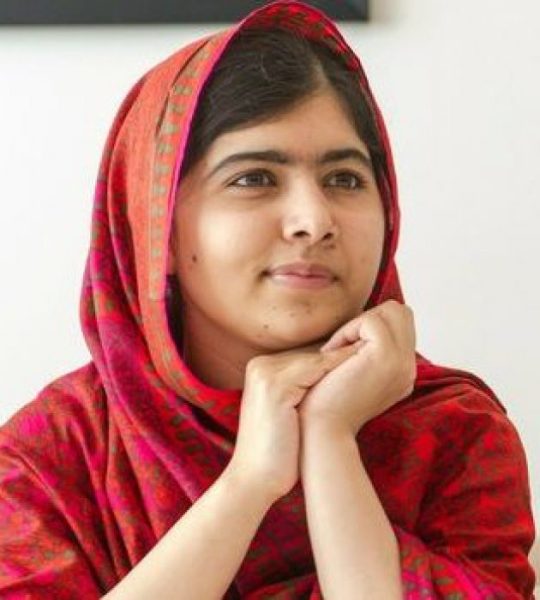
#10 amazing women#happy international women's day#women activists#women of color#international women's day#feminism#millicent fawcett#rosa parks#ruth ginsburg#patricia bath#waris dirie#malala yousafzai#women's day#women's week
5 notes
·
View notes
Video
youtube
gr_OOves ‘n j A_ms S // O // T // Y 2o2o
nO. 15/50
“Tip Toe” by Sleepy Hallow x Sheff G
DV:
I have never and will never watch Insidious, but apparently they used Tiny Tim’s “Tiptoe Through The Tulips” in that film? Instead of waiting for Sleepy Hallow and Sheff G to bring it to its natural afterlife as the extreme banger that is “Tip Toe”? Honestly this seems disrespectful! But I guess one generation’s kitsch is the next’s banger/creeper, sure, why not. What matters is that “Tip Toe” slaps, breathing new life into an old template. And a lot of that is down to producer Great John flipping Tiny Tim’s 1968 novelty hit: why speed up your sample when you can just find an original track that’s sung in a falsetto so ludicrous that it sounds like it must be pitch-shifted? But the other half is how smoothly Sleepy Hallow and Sheff G float over Tim���s unworldly vocal loop, their lengthy verses slightly loopy but always engaging. Sure, anything can be creepy if you edit it right - but “Tip Toe” is one of the most fun three minutes I heard this year.
MG:
I also can’t speak to the quality of Insidious but “Tiptoe Through The Tulips” has always carried an air of the supernatural creep in its helium vocals and tinny ukulele, so I’m not surprised to find it made its way into a horror movie. I suppose I’m also not surprised to hear it on the dark and gruff (but also, ultimately, silly) “Tip Toe” because this sort of unexpected but flawlessly executed sample is one of post-modern rap’s chief thrills. What I feel is more of a relieved sense of “finally!” because pretty much anything DV or I could play during an all night 45s party deserves to find a new context where the grooves can’t wear out. Would I love to hear what Sleepy Hallow could do with Great John sampling “San Francisco (Be Sure to Wear Flowers in Your Hair)”? Oh. Yes. “Spirit In the Sky”? “Some Velvet Morning”? Yes. Yes. Is there a single 60s one hit wonder I don’t want to hear reworked by rappers for whom that decade is as far removed as the Suffragettes were to the Beatles? Maybe “Sugar Sugar” but then I think of what Megan Thee Stallion could do with the idea of a candy girl and I’m all in. Our nonstop consumer culture presses upon us the idea that everything must be used and disposed of, the quicker the better, and that applies to art above all. We’ve stopped dismissing the work of producers who sample as thievery (small victories!) but I don’t think we properly appreciate how they take forgotten pieces of junk and polish them up for resale, giving otherwise garbage a second life.
3 notes
·
View notes
Photo

Lenin is associated with Iskra (Spark) and the Bolsheviks with Pravda (Truth); Trotsky with Nasha Slovo (Our Word), the Italian revolutionary Antonio Gramsci with Ordine Nuovo (New Order), the Polish-German Rosa Luxemburg with Rote Fahne (Red Flag) and the suffragette Sylvia Pankhurst with the Workers’ Dreadnought. In Ireland James Connolly’s name is irrevocably linked with the Workers’ Republic and in Australia, the revolutionary Industrial Workers of the World with Direct Action.
This is not accidental. They were all revolutionaries with a commitment to mass action. A regular publication is the bridge between the ideas of revolutionaries, who are in a minority most of the time, and masses of people.
The revolutionary publication aims to convince readers of a coherent view of society and argues for strategies and tactics to change it. This contrasts with the undifferentiated range of trivia and important events presented in the capitalist press, all based on “common sense” assumptions: it is right for the rich and powerful to rule over the poor and disempowered, “we” Australians are united against all foreigners, strikes are bad and competition is “natural” and good.
READ MORE: Why we sell a socialist publication
#auspol#socialism#socialist#marxism#marxist#leftblr#leftism#left wing#anti capitalist#anti capitalism#revolution#class struggle#communism#communist
7 notes
·
View notes
Text
A list of 100 remarkable women from Polish history - for the anniversary of the 100 years of Polish independence!

My random choice of 100 notable, inspirational and controversial women known from the history of Poland - people of various different backgrounds and occupations, and with interesting, happy or tragic stories.
If you think I missed an important person you adore or feel inspired by (there are so many more I could include below!), then feel free to expand the list by adding an extra in the reblogs!
(you can click the links under their names to read a bit more, however some of them point to Polish articles only - sorry! I’m hiding the list under ‘read more’ for the reblogs because it’s obviously too long to be browsed comfortably on the dashboard!)
Jadwiga of Poland (1384-1399), who was crowned with the title of ‘King’ during an era when female rulers were relatively uncommon in Europe. She donated most of her personal wealth (including royal insignia) to charity and education, funding and restoring many schools and hospitals, and focused on maintaining peace and development during her rule.
Nawojka (14th/15th-century), who was a semi-legendary woman known to attend studies at the University of Kraków (later known as Jagiellonian University) in the 15th century, which she entered illegally dressed as a boy. She is considered to be the first historically acknowledged female student and teacher in Poland.
Magdalena Bendzisławska (17th/18th century), who was the first historically attested female surgeon in Poland. The dates of her birth and death are sadly unknown, and the main document confirming her existence and profession is a diploma issued by King Augustus II the Strong in the year 1697. She took over the role from her husband after he passed away, and she worked as the chief surgeon at the famous salt mine in Wieliczka.
Maria Skłodowska-Curie (1867-1934), who was a Polish and naturalized-French physicist and chemist, the first woman to win a Nobel Prize (which she got along with Pierre Curie and Henri Becquerel) – the only woman to win the prize in two fields, and the only person to win in multiple sciences. She was the first scientist who conducted pioneering research on radioactivity, and she discovered the elements radium and polonium (the second named after her beloved home country).
Emilia Plater (1806-1831), who was a Polish-Lithuanian noblewoman and a revolutionary fighter in the partitioned Polish-Lithuanian Commonwealth. She fought in the November Uprising of 1830, during which she raised a small unit and received the rank of a Captain in the Polish-Lithuanian insurgent forces. She is a national heroine in Poland, Lithuania, and Belarus, all formerly parts of the Polish-Lithuanian Commonwealth.
Irena Sendler (1910-2008), who was a nurse working in Warsaw when WW2 started. She joined the secret Polish resistance organization Żegota (codename for 'Council of Aid to the Jews’). Despite many dangers she managed to rescue around 2,500 Jewish children by smuggling them out of the Warsaw Ghetto in occupied Warsaw, with the assistance of other members of Żegota. She’s on the list of the Righteous Among the Nations.
Maria Szymanowska (1789-1831), who was a skillful composer and one of the first professional virtuoso pianists of the 19th century. She toured extensively throughout Europe during the 1810s and was one of the first pianists to perform a memorized repertoire in public. She is known as the first female composer from Poland to achieve both national and international recognition.
Narcyza Żmichowska (1819-1876), who was a novelist and a poet, considered the precursor of the organized feminism movement in Poland. She inspired and co-founded a group called Entuzjastki (transl. Enthusiasts, which was a progressive association founded in 1830 in Warsaw by a group of women intellectuals in favor of equal rights for men and women). She was among many Polish intellectuals exiled after the failed November Uprising of 1830, after which she settled in Paris where she enrolled at the Bibliothèque Nationale, becoming one of the first women at the French Academy ever. Her first published novel was Poganka (The Heathen) in which she expressed interest in her female friend Paulina Zbyszewska. She was deemed an 'eccentric’, smoked cigars (prohibited for women at that time), and refused to marry. After returning to Poland she founded a group of suffragettes in Warsaw, active in the 1840s, who also took part in anti-tsarist activities.
Klementyna Hoffmanowa, nee Tańska (1798-1845), who was a writer, translator, and editor. She was the first woman in Poland to fully support herself financially from writing and teaching, and to consider herself primarily a writer by a profession. In 1831 she moved to Dresden and later to Paris, and was later called 'the Mother of the Great Emigration’ (mass emigration or exile of the Polish elites, mainly to Western Europe, after the failure of the anti-tsarist November Uprising of 1830 during the time Poland was under Partitions).
Simona Kossak (1943-2007), who was an award-winning scientist and ecologist. She spent over 30 years living in a hut in the Białowieża wilderness, Europe’s oldest primeval forest located on the border between Poland and Belarus where she grew close to the wild animals to the point it looked like she could understand their language, which gave her the nickname 'witch’.
Bona Sforza (1494-1557), who was a member of the Milan-based House of Sforza and became the Queen of Poland and Duchess of Lithuania by marriage to King Sigismund I the Old. She was known for her ambitious and energetic nature, ensuring a strong political position on the Polish court almost right from the beginning of her marriage. She was responsible for many economic and agricultural reforms implemented in Poland and Lithuania, eventually making her the richest landowner in the Grand Duchy.
Princess Izabela Czartoryska (1746-1835), who was a writer, art collector, and prominent figure of the Enlightenment movement. Her palace was an important political and intellectual meeting place, known as one of the most liberal and progressive court in the pre-Partitioned Commonwealth. She was the founder of Poland’s first museum, which she called the 'Temple of the Sibyl’ or 'Temple of Memory’ (later moved to Kraków where it exists under the name of Czartoryski Museum).
Countess Karolina Lanckorońska (1898-2002), who was an art historian and philanthropist. During WW2 she was an anti-Nazi and anti-communist resistance fighter of the Polish underground, and survived a German concentration camp for women (as a political prisoner). After the war she refused to live in Poland under the communist rule and spent most of her life abroad as a political émigré. She inherited her family’s enormous art collection, which she donated to the Polish state only after 1989 – after Poland underwent a democratic transition.
Elżbieta Zawacka (1909-2009), who was a Polish university professor, scouting instructor, SOE agent, and freedom fighter during WW2 (using the codename 'Zo’). She was the only woman in the elite special unit Cichociemni ('Silent Unseen’) of the Polish underground, served as a courier carrying letters outside of the German-occupied Poland, and fought in the 1944 Warsaw Uprising.
Irena Kempówna-Zabiełło (1920-2002), who was a skilled pilot and renowned glider. In 1949 and 1950 she established two world speed records for women: over a triangular course of 100 km and over a straight distance of 100 km.
Elżbieta Sieniawska (1669-1729), who was a noblewoman, Grand Hetmaness of the Crown, and renowned patron of arts. She was described as a 'lady of great wisdom, reason and shrewdness’, and she was deployed by her husband on diplomatic missions, duties, and obligations that he could not manage. As an influential woman politician in the Polish–Lithuanian Commonwealth during the reign of Augustus II the Strong, she was deeply embroiled in the Great Northern War and in Rákóczi’s War for Independence. She was considered the most powerful woman in the Commonwealth and called the ‘uncrowned Queen of Poland’.
Michalina Wisłocka (1921-2005), who in the 1970s published the first guide to sexual life in communist countries, focusing on women’s needs. She fought for equal rights for women in a bid to fully participate in public, political, and economic life at that time.
Tamara de Lempicka (1898-1980), born Maria Górska, who was a renowned painter of the Art Deco movement and gained international fame for her decorative portraits. She is known for her unconventional style of self-expression, and her art manifested bisexual, bold, liberated female sexuality.
Zofia Stryjeńska (1891-1976), who was a painter, graphic designer, illustrator, and stage designer, one of the best-known Polish women artists of the interwar period. In 1911 she was briefly studying abroad at the Academy of Fine Arts in Munich, where she enrolled using the name of her brother and dressed like a boy, because at that time the academy did not accept women. She grew in fame in Poland during the interwar period for her style inspired by the Polish folklore and Slavic paganism.
Jadwiga Grabowska (1898-1988), who was nicknamed the 'Godmother of the Polish fashion industry’ during communist rule. She promoted the modern 'tomboy’-ish style of the 1950s and 1960s and was responsible for persuading the state-owned textile industries to produce a wide range of colorful fabrics available for common women, coming under constant criticism from supervisors and governmental authorities.
Pola Negri (1896-1987), who was a stage and film actress during the silent and golden eras of Hollywood and European film, famous for her femme fatale roles. She was the first European film star to be invited to Hollywood and became one of the most popular actresses in the American silent film era. She started several important women’s fashion trends at that time that are still staples of the fashion industry.
Maria Konopnicka (1842-1910), who was a poet, novelist, children’s writer, translator, journalist, and activist for women’s rights and for Polish independence under the Partitions, as well as an activist against the repression of ethnic and religious minorities in Prussia. Her life was turbulent, and her sexual orientation is widely speculated on by modern historians. After an unhappy marriage, she spent most of her late life living in a romantic relationship with the painter and feminist Maria Dulębianka.
Maria Dulębianka (1861-1919), who was a social activist, feminist, painter, writer, and publicist. She was a prominent representative of the suffragette movement. She promoted women’s right to political participation and in 1908 enrolled herself as a candidate to the Galician Parliament (in the Austrian partition of Poland), where she was denied ‘due to formal reasons’. Her social work included founding of many children’s nurseries and kitchens for the poor, as well as setting up a help and activity club for homeless street kids. She was known to wear ‘masculine’ clothes.
Maria Dąbrowska, nee Szumska (1889-1965), who was a writer, novelist, essayist, journalist, and playwright, author of the historical novel Noce i dnie (Nights and Days). She was nominated for the Nobel Prize in Literature four times. She specialized in the themes of human rights and human potential for development under life hardships. In her personal life, she is considered one of a few historically-confirmed Polish bisexuals. She maintained long-term open relationships – first a marriage with publicist Marian Dąbrowski until his death in 1925, then a concubinage with painter Henryk Szczygliński until his death in 1952. She spent the remaining years of her life living in a romantic relationship with a writer Anna Kowalska (also a widow at that time), whom she had first met during the WW2 period, when they had fallen in love. In her articles published for the Polish press during the interwar period she openly advocated tolerance for homosexuality and diversity of society.
Grażyna Bacewicz (1909-1969), who was a composer and violinist. She is only the second Polish female composer to have achieved national and international recognition. She belonged to a large group of Polish composers from the interwar and post-war years creating in the neoclassical style. Despite constant pressure from the postwar communist government, she never composed any socialist realist work on their orders.
Anna Jagiellon (1523-1596), who was the Queen of Poland and Grand Duchess of Lithuania. Despite multiple proposals, she remained unmarried until the age of 52. Then she was elected, along with her then-fiancé Hungarian noble Stephen Báthory, as the co-ruler of the Polish-Lithuanian Commonwealth. Their marriage remained rather a formal agreement for the following 10 years, until the death of Báthory. She didn’t take the opportunity of claiming the throne for herself. During her reign she spent most of her time in Warsaw on local administrative matters and sponsoring construction works, adding greatly to the development of the city.
Irena Krzywicka (1899-1994), who was a controversial Polish-Jewish feminist, writer, translator, and activist for women’s rights. During the interwar period she became one of the most famous feminists in Poland, spreading knowledge about sexual education and birth control. She was considered a scandalist at that time as, she talked openly about abortion, women’s sexuality, and homosexuality.
Helena Modrzejewska, known also as Modjeska (1840-1909), who was a renowned actress specializing in Shakespearean and tragic roles. She emigrated to the USA in the 1870s where, despite her imperfect accent, she achieved great success, eventually gaining a reputation as the leading female interpreter of Shakespeare on the American stage. She was a women’s rights activist, describing the difficult situation of Polish women under the Russian- and Prussian-ruled parts of Partitioned Poland. Her speeches led to a Tsarist ban on her traveling to Russian territory.
Hanka Ordonówna (1902-1950), born Maria Anna Pietruszyńska, who was a singer, dancer, and actress, one of the main stars during the interwar period in Poland. In 1931 she became a countess by marriage to Michał Tyszkiewicz, which made her an adored legend among lower classes of society who dreamed about a similar romantic life. Her career ended with the outbreak of WW2. She was arrested a few times as a political enemy and eventually sent to a gulag (Russian labor camp) in Uzbekistan where her chronic lung disease worsened dramatically. She was eventually evacuated to Beirut, where she stayed until her death, hoping to fight the disease.
Maria Pawlikowska-Jasnorzewska (1891-1945), who was a renowned dramatist and poet in Poland, known as the 'queen of lyrical poetry’ of the interwar period and the 'Polish Sappho’. She established herself as one of the most innovative poets of her era, writing about many taboo topics such as abortion, extramarital affairs, and incest, which provoked numerous scandals. Her plays depicted her unconventional approach to motherhood, which she understood as a painful obligation that ends mutual passion. She spoke in support of a woman’s right to choose. She has a minor planet named after her, thanks to the Czech astronomer Zdeňka Vávrová.
Barbara Radziwiłł (1520/23-1551), who was briefly the Queen of Poland and Grand Duchess of Lithuania as the consort of King Sigismund II Augustus (the last male monarch of the Jagiellon dynasty). They married in secret in 1547, after a few years of a love affair, causing a huge scandal. Her life became surrounded by many rumors and myths, and she became the heroine of many legends that inspired numerous paintings, literary works, and films.
Maria Wittek (1899-1997), who was a soldier promoted to brigadier general in the Polish Army, the first woman ever to acquire that rank in Poland (but only in 1991, after the collapse of the communist government). At the age of 18 she joined the underground Polish Military Organization (Polska Organizacja Wojskowa) and completed the NCO (non-commissioned officer) training course. During the First World War she fought against the Bolsheviks as a member of the Voluntary Legion of Women. Between 1928-1934 she was the commander of the Female Military Training (Przysposobienie Wojskowe Kobiet – an organization training women for military service. During WW2 she became the commanding officer of the Women’s Military Assistance Battalions and fought in the 1944 Warsaw Uprising. After the war she initially returned to her previous position as a head of the women’s military division, but in 1949 she was arrested by the communist authorities and spent several months in prison. After her release she worked in a newspaper kiosk. She never married.
Maria Kazimiera d’Arquien (1641-1716), born Marie Casimire Louise de La Grange d'Arquien (and known in Poland by the diminutive name 'Marysieńka’) who was the Queen Consort to King Jan III Sobieski. They were remembered as a compatible couple, rare in those times for high-status marriages. Their love letters reveal authentic feelings between the loving pair, but also their reflections on contemporary issues and difficulties, as well as down-to-earth matters concerning the royal household and little day-to-day decisions made by the monarch, who often consulted his wife about them.
Magdalena Abakanowicz (1930-2017), who was a sculptor and fiber artist, widely regarded as one of Poland’s most internationally-acclaimed artists. She’s known for her experimental sculptures, such as the series called Abakans: gigantic three-dimensional fiber works created in the 1960s that placed her in the international art world as one of the greatest and the most influential figures of that time. She created many large-scale projects such as the art installation Agora, consisting of 106 headless and armless iron sculptures located in Grant Park in Chicago.
Anna Jabłonowska (1728-1800), who was a magnate and politician, referred to as one of the most significant women of 18th-century Poland. She was known for remarkable activity on her estates, introducing numerous management reforms and funding hospitals, factories, schools, and a printing press, all with the wellness of the people living on her estates in mind. She was known for her personal interests in science and botany. Her naturalist collection was one of the best in Europe.
Olga Boznańska (1865-1940), who was a notable painter combining the impressionism and realism movements. She was known for her unique style and intimate portraits, emphasizing the spirituality of her models. She was widely acclaimed during her lifetime and today is regarded as one of the most significant Polish painters.
Anna Dorota Chrzanowska (17th century), who became a heroine of the Polish–Ottoman War (1672–76). She was the second wife of Captain Jan Samuel Chrzanowski. During the war they were stationed in Trembowla Castle, besieged by the Ottoman Turks. The castle managed to withstand many attacks, and the defenders underwent an internal crisis only after several days when shortages of food and water became severe. The captain decided to surrender, but his wife disagreed with his decision – she urged the defenders to carry out a daring attack on the Turkish positions, which is said to have raised the morale among the Poles greatly, and led the soldiers out herself, resulting in heavy losses among the Ottomans. Due to her act she has been called the 'Polish Joan of Arc’.
Anna Rajecka (c.1762-1832), later known as Madame Gault de Saint-Germain, who was a portrait painter and pastellist, recognized for her talent and raised as a protégé of King Stanisław August Poniatowski. She was one of a few women who frequently attended the king’s famous Thursday Dinners, and therefore she was rumoured to be his illegitimate daughter or his mistress (neither true as far as historians have researched). In the early 1780s, she was enrolled at the king’s expense at the art school for females at the Louvre in Paris and stayed in the city after falling in love and marrying a French miniature artist. She became the first Polish woman to have her work presented at the Paris Salon.
Jadwiga Szczawińska-Dawidowa (1864-1910), who was an activist, publicist, and teacher. She founded the so-called Flying University, an underground educational organization primarily for women. It operated in secret in private apartments in Warsaw (changing the location frequently – hence the university’s name) at the time when that part Poland was under control of the Russian Empire, providing educational courses outside the occupiers’ censorship at the time. During the 20 years of the university’s existence, around 5,000 women graduated from it, among them Maria Skłodowska – later a Noble prize winner.
Countess Maria Walewska (1786-1817), who was a Polish noblewoman remembered most for her long-lasting affair with Emperor Napoleon I. According to his memoirs, Napoleon remembered her for her extraordinary beauty after only a brief meeting in 1806, and requested to meet her again. She was said to be pious for her time and status, and admitted to have forced herself to get involved with Napoleon for purely patriotic reasons. She sought to influence his Eastern European policy, and during the affair she convinced him to create the Duchy of Warsaw.
Katarzyna Kobro (1898-1951), who was a notable avant-garde sculptor of the constructivist and abstract movements. She co-founded a few major Polish and international modernist artistic groups in the 1920s and 1930s. She signed a number of manifestos, including the early-modern Dimensionist Manifesto (concerning a “new conception of space and time”). She was most famous for her “spatial sculptures” – combinations of rigorously architectural structures, sculptural forms, and constructivist aesthetics.
Zofia Nałkowska (1884-1954), who was a prose writer, dramatist, and prolific essayist. During the interwar period she became one of Poland’s most distinguished feminist writers of novels, novellas, and stage plays characterized by socio-realism and psychological depth. In her writings, Nałkowska boldly tackled subjects which were difficult and controversial at that time, such as eroticism.
Jadwiga Sikorska-Klemensiewiczowa (1871-1963), who was a pharmacist, and one of the first official female students in the history of Jagiellonian University, after graduating from the underground Flying University. She became the first chairwoman of the General Association of Working Women in Poland.
Scholastyka Ostaszewska (1805-1851?), who was a social activist and an underground independence activist. She belonged to the group Entuzjastki (a progressive association founded in 1830 by a group of female intellectuals in favor of equal rights for men and women). Around 1848 she was active in a female branch of the Polish People’s Spring movement, which fought for independence from Partitions. In 1851 she was put under strict police supervision by the Russian occupants. Her date of death is unknown.
Alina Szapocznikow (1926-1973), who was a sculptor and illustrator representing the surrealist, nouveau realist, and pop art movements. She is mentioned among the most important Polish artists of her generation. She was born to a Polish-Jewish family and survived the Holocaust during the Nazi Germany’s occupation of Poland. That period of her life made a huge impact on her art. She created a visual language of her own to reflect the changes going on in the human body and introduced new sculpting materials and forms of expression.
Zofia Daszyńska-Golińska (1866-1934), who was a socialist politician, suffragette, university professor, and early female senator in interwar Poland. She was a member of a number of leading feminist organisations, including the Little Entente of Women.
Kazimiera Bujwidowa (1867-1932), who was a notable feminist and suffragette in Poland. She was involved in campaigns to improve general education and literacy in Warsaw and Kraków, and she organized the first Kraków Reading Room for Women. She is credited with starting the first junior school for girls and for campaigning for women’s admission to Jagiellonian University as students (as they got in 1897).
Maria Kokoszyńska-Lutmanowa (1905-1981), who was a notable logician and author of studies in philosophy, methodology, epistemology, and semantics. For some years after WW2, she was viewed as dangerous enough by the communist government to be deprived of the right to teach philosophy, being able to teach logic only.
Gabriela Zapolska (1857-1921), who was a novelist, playwright, naturalist writer, feuilletonist, theatre critic, and stage actress. She received the most recognition for her socio-satirical comedies in which she mocked the moral hypocrisy of the upper classes (she herself was born to a wealthy family of Polish landed gentry). Her most famous work, The Morality of Mrs. Dulska (written in 1906), became a key work in early modernist Polish drama. In it, she criticized the hypocritical double standard of sexual behaviours and two-faced family values.
Stefania “Barbara” Wojtulanis (1912-2005), who was an experienced glider, balloon and motor aircraft pilot, and parachute-jumping instructor (she received licenses for all of the above before her 24th birthday). At the start of WW2 she was promoted to the rank of first lieutenant, assigned to the general staff of the Polish army, and flew missions to deliver fuel to the fighter brigade defending against the 1939 attack on Warsaw. She was evacuated to Great Britain in 1940 and later assigned to the Air Transport Auxiliary as a ferry pilot, where she logged over 1,000 hours of flying. She was twice awarded the Silver Cross of Merit for her services during the war and was honoured at the International Forest of Friendship with a plaque for her aviation achievements.
Helena Mniszkówna (1878-1943), who was a novelist and author of several books popular in pre-war Poland. She debuted with the novel Trędowata (The Leper, 1909) that brought her to prominence and became one of the most famous Polish melodramas (later in the 20th century dramatised four times by different directors). In 1951 all of her works were banned by communist censors in People’s Republic of Poland due to their bourgeoisie content, which they deemed 'may have been harmful for society’.
Eleonora Ziemięcka (1819-1869), who was considered the first female philosopher in Poland. She bravely entered that field at the time it was reserved exclusively for men. She played a significant role in the history of Polish philosophical thought at the time, representing the so-called Polish religious thought (or Polish Messianism). Her Thoughts on the Upbringing of Women, published in 1843, was the first book in which the issues of reforming women’s education and their need to develop the mind were addressed.
Maria Ilnicka (1825-1897), who was a poet, novelist, translator, and journalist. In 1863/1864 she took part in the January Uprising against the Russian Empire, as an archivist of the underground Polish National Government. She was promoting feminism and organic work. In 1865 she was the editor-in-chief of a weekly magazine for woman, Bluszcz.
Wanda Rutkiewicz (1943-1992), who was a computer engineer and a mountain climber. She is known as the third woman, the first Pole, and the first European woman to reach the summit of Mount Everest, which she accomplished in 1978. In 1986 she became the first woman to successfully climb K2, what she did without supplemental oxygen.
Zofia Rogoszówna (1881-1921), who was a poet, translator, and writer of children’s literature. She was the first female writer in Poland who adapted rural short stories and rhymes into the literature for children, which she compiled in three tomes over time. She is considered a valuable researcher of folklore.
Jadwiga Piłsudska (1920-2014), who was a pilot. She obtained her first pilot’s licence in 1937 (at the age of 17), then her aircraft pilot’s license in 1942, and served in the Air Transport Auxiliary during WW2. As a daughter of the Marshal Józef Piłsudski, she remained in Great Britain after the war as a political émigré. She never accepted British citizenship and used a stateless person passport, valid for all countries in the world except the communist People’s Republic of Poland. She was able to return safely to her country only in 1990, after the collapse of the communist government.
Lucyna Ćwierczakiewiczowa (1829-1901), who was a writer, journalist, and author of several popular Polish cookbooks. After 1875 she devoted herself to preparing a yearly publication, Kolęda dla Gospodyń (A Housewife’s Carol), a calendar filled with cooking recipes, women’s suffrage ‘propaganda’, and short novels and poems. Her books made her the best-selling author in pre-war Poland. By the year 1924 her first cookbook was issued 23 times, with more than 130 thousand copies sold worldwide – more than all the books by the novelists and Nobel Prize laureates Henryk Sienkiewicz and Bolesław Prus combined had sold before that year.
Anna Leska (1910-1998), who was a skilled pilot assigned to the Polish Air Force HQ squadron to fly liaison missions. After the 1939 defeat of Poland, she was evacuated to Great Britain and started ferrying aircraft with the Air Transport Auxiliary (ATA) where she eventually became a flight leader in charge of eight female ferry pilots, whom she instructed and assisted. She was one of only three Polish women serving in the ATA, and the only woman flying in the ATA to receive the Royal Medal.
Zofia Sokolnicka (1878-1927), who was a social and political activist and member of parliament after Poland regained independence in 1918. During the First World War she worked as a courier – thanks to her outstanding memory, she could convey detailed political information and instructions without transporting any papers or notes.
Izabela Elżbieta Morsztyn (1671–1756), who was a noblewoman, known for her political salon and role in the Familia (an 18th-century political party or fraction led by the House Czartoryski and allied families). In 1736 in Warsaw, she established the first political salon, where politicians met and the Familia party conferred. Women played a significant role in those meetings.
Princess Konstancja Czartoryska (c.1696-1759), who was a noblewoman, later known as the mother of King Stanisław August Poniatowski. She was described as a serious person with an interest in education and politics, strongly devoted to her mother Izabela Elżbieta Morsztyn. She played a political role as a driving force within the Familia (political party led by House Czartoryski). She acquired a great influence within the family and led the political careers of her spouse and brothers. At the interregnum and royal election after the death of King Augustus II in 1733 she, alongside her mother and Zofia Czartoryska, were described as the most influential people in the Familia party, and she was represented her faction during negotiations (e.g., with a French ambassador).
Stefania Sempołowska (1869-1944), who was an educator, social activist, and writer. At the age of 17 she passed the Teacher Patent at the Government Commission in Warsaw. She became a teacher and children’s rights activist, and was the author of many school books. During the Revolution in the Kingdom of Poland (1905) against the Russian Empire, she initiated a congress of delegates of the Polish teacher organizations, in which solidarity with the protesting common people was declared and the teachers decided to run lessons in the Polish language despite Russian prohibition.
Faustyna Kowalska (1905-1938), born Helena Kowalska, who was a nun and mystic. Throughout her life, she reported having visions of Jesus and conversations with him, which inspired the Roman Catholic Divine Mercy devotion and earned her the title of 'Apostle of Divine Mercy’. Based on her descriptions, the famous Divine Mercy image was created (she herself didn’t know how to paint, so she asked a few painters to recreate her vision on canvas, resulting in a few known versions of the scene). She was canonized in 2000.
Helena Radlińska (1879-1954), who was a teacher, historian, and librarian, and the creator of the Polish school of social pedagogy. She promoted librarian pedagogy, readership, the creation of home book collections, and access to literature for different social groups (especially those from culturally underprivileged groups).
Irena Morzycka-Iłłakowicz (1906-1943), who was a Polish second lieutenant of the National Armed Forces and an intelligence agent. During WW2 she was active in the Polish resistance movement and conducted military, economic, and intelligence reconnaissance. Her section was destroyed by the Nazi Germans, followed by numerous arrests of underground activists. She was captured in October 1942 and underwent harsh interrogations. She was rescued by fellow underground agents: first a bribed guard put her in the group of non-political prisoners to be transported to the Majdanek camp, from where she was rescued by agents dressed in stolen German uniforms. She continued her work as an agent. In the days before her death she was involved in an action against a radio contact point which supported Soviet Russian activities in Poland. She was murdered in 1943 in unknown circumstances after being summoned for an important meeting. Because the Nazi Germans often sent agents to family funerals (and other ceremonies), she was buried under a false name, and her husband participated in the funeral dressed as a gravedigger; her mother as a cemetery helper. Only in 1948 did her mother place a plaque with her true name on the grave.
Maria Grzegorzewska (1888-1967), who was a Polish educator and teacher. She introduced and developed the special education movement in Poland. Maria Grzegorzewska worked out the original teaching method, called “the methods of working centers” focused on a creative work environment, which is still used in today’s special needs education. She was the first to start systematic research on pedagogical issues of the disabled in Poland.
Agnieszka Osiecka (1936-1997), who was a poet, writer, author of theatre and television screenplays, film director, and journalist. She was a prominent Polish songwriter, having authored the lyrics to more than 2,000 songs, and is considered an icon of Polish culture.
Barbara Sanguszko (1718-1791), who was a noblewoman, poet, translator, and moralist during the Enlightenment in Poland. She organised and hosted a salon in Poddębice, where the gathering of intellectuals, artists and politicians was modelled after French 18th-century salons. Sanguszko was known for her piety, generosity and philanthropy. She not only restored many Catholic churches and convents, but laid the foundations of new religious houses, including also Orthodox churches. Having in mind the future of her children and of the family estate, she took an active part in the political life of her country. She took it upon herself to attend parliaments and tribunals. Her soirées spawned the future theatrical initiatives of the Lazienki Palace. She hosted grand occasions in the Saski Palace, including illuminations, concerts and balls for dignitaries of the period.
Barbara Kwiatkowska-Lass (1940-1995), who was a notable film actress. Raised in communist Poland, she took an opportunity to leave the country in 1959 to pursue her career in the West and starred in a few major Italian, German, and French films. She actively opposed the communist regime and cooperated with the United States-controlled Radio Free Europe/Radio Liberty, which transmitted anti-communist propaganda, information, and programmes free from censorship to Poland.
Anna Iwaszkiewicz (1897-1979), who was a writer and translator, born to the family of a wealthy entrepreneur. She entered Polish artistic circles by marriage to Jarosław Iwaszkiewicz (then a novice writer) and they both were known for their turbulent bisexual orientation. During WW2 she and her husband actively helped rescue Jewish people from the Nazi German occupiers by hiding them, finding new shelters, and providing them with funds and with false documents. She is on Israel’s list of the Righteous Among the Nations.
Katarzyna Ostrogska (1602–1642), who was a Polish–Lithuanian noblewoman, known as the founder of the city of Biała (modern Janów Lubelski). She was married to the nobleman and voivode Tomasz Zamoyski. Widowed in 1638, she took over management of the Zamoyski estates. In 1640 the king granted her the privilege to found the city of Biała, including the right to organize the government of the city and appoint its officials. She wrote several documents regulating life in her city.
Alina Centkiewicz (1907-1993), who was a writer and explorer, as well as the co-author of many travel books (written with her husband). She was best known for her descriptions of the Antarctic Circle region. In 1958 she was the first Polish woman (and the sixth woman in the world) to explore Antarctica.
Wanda Gertz (1896-1958), who was a soldier and independence activist. Born to a noble family, she began her military career in the Polish Legion during the First World War dressed as a man, under the male pseudonym of Kazimierz Zuchowicz, or 'Major Kazik’. With the outbreak of WW2, thanks to her experience and skills she became an officer of an all-female battalion in the underground Home Army, where she took the codename 'Lena’, and created a female division and sabotage unit. She was captured after the failed 1944 Warsaw Uprising and remained imprisoned in various German camps until the liberation by the US army in 1945. After the war she travelled throughout Germany and Italy in a search of displaced Polish women, joining the Polish Resettlement Corps. After demobilisation she worked in a canteen until her death.
Ewa Szelburg-Zarembina (1899-1986), who was a novelist, poet, and screenplay writer, best known as the author of numerous works for children. She co-initiated a fundraising program that eventually led to the construction of the Children’s Memorial Health Institute, the largest and the most modern centre of paediatric care for children in Poland.
Anna Kostka (1575–1635), who was a Polish–Lithuanian noblewoman. She inherited the city of Jarosław as well as several other areas from her mother. After being widowed in 1603, she lived an independent life as the manager of her and her children’s dominions. She financially supported the University of Jarosław, introduced the Benedictine Order to the city, protected the Jesuits, commissioned several (later famed) art objects for the churches, and became known for her charity toward the poor.
Seweryna Szmaglewska (1916-1992), who was a writer, known for books for both children and adults alike. During WW2 she was arrested by the Nazi Germans in a łapanka (street roundup), and sent to the Auschwitz-Birkenau concentration camp as a political prisoner. She survived three years in the camp, and after the war she was one of very few Poles to testify at the Nuremberg Trials. She collected her memoirs in a few books, the most famous being Smoke over Birkenau.
Janina Lewandowska (1908-1940), born Janina Dowbor-Muśnicka, who was a second lieutenant in the Polish air force, devoted entirely to her flying career. After the outbreak of WW2 she was drafted for service in the 3rd Regiment, but her unit was taken hostage by Soviet forces in unknown circumstances. She was one of only two officers in the imprisoned group. She died in the infamous 1940 Katyn Massacre, and her remains were identified only in 2005.
Wanda Błeńska (1911-2014), who was a tropical disease expert and missionary who succeeded in developing the Buluba Hospital in Uganda, an internationally recognized centre for leprosy treatment.
Aleksandra Zagórska (1884-1965), who was am independence activist and soldier. During the First World War she commanded the women’s intelligence service in the Polish Legions. In 1918 she formed the female paramilitary organization Ochotnicza Legia Kobiet (Voluntary Legion of Women) and served as the organization’s commander. In her military career she was eventually promoted to the rank of lieutenant colonel. During WW2 she joined the resistance as part of the left-leaning Coalition of Independence Organisations. After the war she lived under the pseudonym 'Aleksandra Bednarz’ to avoid the communist government’s persecution on account of her history of independence activism.
Maria Nostitz-Wasilkowska (1858-1922), who was a painter and portrait artist, nicknamed ‘Charmante Polonaise’ by the upper classes. Her favourite medium was pastels, and she specialized in female portraits, valued for her ability to interpret the model’s psychology through subtle color and light. Her portraits were often described as 'living and vibrant’, as if she caught the model in an ephemeral moment. She graduated with honors from the art academy in Saint Petersburg and paved her way to become a favourite artists of the elites in Saint Petersburg and Warsaw, travelling between those cities during her lifetime. Sadly, not many portraits by her have survived to the modern day.
Lena Żelichowska (1910-1958), who was a dancer and actress, one of the most popular in interwar Poland. She debuted on screen in 1933 and quickly gained popularity, becoming one of the most promising film stars in Poland. Before the outbreak of WW2 she managed to appear in 14 movies and starred in numerous theatre plays. During the early stages of the war, she and her husband Stefan Norblin (a notable art deco artist) escaped Poland, and only his reputation as a painter opened many doors, including those of the royal family in Iraq and the Maharajahs in India, where they lived until the end of the war. In the late 1940s they eventually settled in the US. Due to her accent she never managed to return to acting.
Krystyna Skarbek (1908-1952), also known as Christine Granville, who was a WW2 spy working for the British Special Operations Executive. She became celebrated especially for her daring exploits in intelligence and irregular warfare missions in Poland and Nazi-occupied France, and she was one of the longest-serving of all Britain’s wartime women agents. After the war, Skarbek was left without financial reserves or a native country to return to (she didn’t recognize the communist government in postwar Poland). Her life is said to be an inspiration for the fictional characters of Vesper Lynd and Tatiana Romanova in the James Bond novels Casino Royale (1953) and From Russia, with Love (1957).
Teresa Bogusławska (1929-1945) was a promising Polish poet and a participant in the 1944 Warsaw Uprising. She joined the Polish scouts’ underground resistance movement at the age of 12. In 1944 (aged 15) she was arrested by the Nazi Germans while pasting independence slogans on German posters. She was imprisoned and tortured during questioning, and suffered badly from tuberculosis after barely three weeks spent in prison. She was freed, but her health never recovered. During the Warsaw Uprising later that same year, she helped the insurgents by sewing uniforms and arm bands. She died early in 1945, aged 16, from meningitis caused by the tuberculosis.
Anna Pustowójtówna (1838-1881), who was a noblewoman, activist, and soldier, famed for her participation in the January Uprising. She identified herself fully as a Pole despite being a child of a mixed Polish-Russian couple, her father being a high-ranking Russian general. She became an activist for the cause of the Polish independence and sided with the Polish troops during the 1963 January Uprising. She disguised herself as a male soldier and went by the alias 'Michał Smok’ (literal translation: Michael the Dragon). She fought as an assistant to the general Marian Langiewicz. She took active part in a few battles, such as the Battle of Małogoszcz, Battle of Pieskowa Skała, Battle of Chroberz, and Battle of Grochowiska, becoming a living legend of the Uprising (much like Emilia Plater, who became a symbol of the November Uprising c. 40 years earlier).
Maria Piotrowiczowa (1839-1863), who was a January Uprising insurgent, participating in the Battle of Dobra (the Łódź province). Upon news of failures of the ongoing uprising, she decided to support the fighters, cutting her hair and putting on a men’s insurrectionary garment. She joined a small troop led by a man from a nearby manor. At the beginning she was on an auxiliary duty, but when the military situation deteriorated she declared her intention of joining front-line duty. In February of 1863 the Russian troops took her unit’s camping site by surprise. She fought to the very end and stayed on the battlefield, rejecting the suggestions of surrender given to her by Russian officers. With a remaining small group of young people, she bravely defended the troop flag donated to the unit by women from the city of Łódź. Armed with a revolver and a scythe, encircled by Cossacks, she killed one, wounded another, and killed the horse under yet another one before dying from their hands. Her body was pricked with pikes and sabres. The tragedy was magnified by the fact that Maria was pregnant at that time.
Natalia Zarembina (1895-1973), who was a writer and journalist. During WW2 she was also a participant of the underground resistance in occupied Poland: she served as an activist of the Polish Socialist Party – Freedom, Equality, Independence (a WW2 underground resistance party) and as a member of the underground organisation Żegota (Council of Aid to the Jews). In late 1942 she published the book Obóz śmierci (Eng. Death Camp), released by the underground press, which was the first document telling about the German concentration camp of Auschwitz. She included firsthand information based on reports of refugees and people dismissed from the camp. Her book was translated to English in the following year, becoming one of the first reports of the Nazi German atrocities in the occupied Poland, followed by the famous Pilecki’s Report.
Eliza Orzeszkowa (1841-1910), who was a journalist, social activist, novelist, and leading writer of the Positivism movement during the late era of the Partitions of Poland. In 1905, along with Henryk Sienkiewicz, she was nominated for the Nobel Prize in Literature. She authored over 150 powerful works dealing with the social conditions of her occupied country.
Teofila Chmielecka (1590–1650) was a Polish military spouse, married to Stefan Chmielecki. She was known for her dedication to the military ideals and for maintaining the Spartan lifestyle necessary in the army, and came to be known as the ideal role model of a military wife. She displayed her personal courage on several occasions, earning the nickname “The Wolf of the Frontier”.
Teofila Ludwika Zasławska (c.1650-1709), who was a noblewoman known as perhaps the most significant landowner in Poland in her time. She was the daughter of Katarzyna Sobieska (sister of King Jan III Sobieski) and an heiress of the Ostrogski family. She was married twice: to the Great Crown Hetman Dymitr Jerzy Wiśniowiecki, and after his death to Prince Józef Karol Lubomirski. Upon her first husband’s death, she inherited large holdings that included the Baranów Sandomierski Castle (not without a legal fight for those rights). After the death of her brother she became the only heir to one of the largest estates in the Commonwealth, the Ostrogski Ordination, which included several dozen towns. As a result of her second marriage, the large landed estates of the Ostrogski Ordination in Poland were transferred to the Lubomirski family. The combined fortune of the Zasławskis and Lubomirskis would become for a time the largest fortune in the Commonwealth. Her second husband had an ongoing extramarital affair which became public, resulting in her attempting to declare him legally insane. They were formally separated until his death in 1702. During the last years of her life she was involved in charity work, including management and development of schools.
Rozalia Lubomirska (1768-1794) was a noblewoman, most noted for her death. At the age of 19 she was married to Prince Aleksander Lubomirski. They travelled to France but, unhappy in her marriage, she decided to divorce her husband and did not accompany him on his way back to Poland. The time of the French Revolution met her in Paris. She was arrested along with her child and tried for alleged conspiracy against the Revolution. As a result, the 26-year-old princess was sentenced to death and soon beheaded by guillotine, although her guilt was (and remains) widely questioned. The death of a Polish national caused much concern among the Polish nobility who, prior to the Reign of Terror, openly cheered the Revolution. Among those who spoke in her defence was Tadeusz Kościuszko. After her death, Rozalia became the subject of legends. According to one, her ghost appears in the Lubomirski Palace in Opole Lubelskie.
Anna Bilińska-Bohdanowicz (1857-1893) was a painter known for her portraits, painted with a great intuition. Her Self-Portrait with Apron and Brushes (1887) developed a new self-portrait pose by placing the artist in front of a model’s backdrop, thus showing that she is her own model. She was internationally recognized during her lifetime and studied art in Paris. After returning to Poland she intended to open a painting school for women in Warsaw, which would have mimicked the practices of the Parisian academies. However the project was stopped short when the artist fell ill with a heart condition.
Zofia Rydet (1911-1997), who was a professional photographer best known for her project 'Sociological Record’, which aimed to document every household in Poland. She began working on that project in 1978 at the age of 67, taking an enormous collection of nearly 20,000 pictures until her death in 1997. The photos show various informal scenes in different ordinary Polish households, often with the owners among their belongings.
Teofila Certowicz (1862-1918), who was a sculptor and artist. For a brief time she opened and managed her own art school for women in Kraków, the first one of that kind in the city, and invited prominent artists such as Włodzimierz Tetmajer and Jacek Malczewski to teach the girls in her school.
Wanda Telakowska (1905–1986) was an artist best known as the founder of Warsaw’s Institute of Industrial Design. She was a member of an Arts and Crafts collective that encouraged a new artistic identity which included folk art. After the WW2 she joined the communist government in Poland, creating the Bureau of Supervision of Aesthetic Production. As the head of the Bureau, she commissioned artists to design many mass-produced Polish goods, under the motto 'Beauty is for every day and for everybody’. However, some artists were suspicious of collaborating with the communist government during a time of continued political conflict. Ultimately, the Bureau was shut down, as the value of artist designs was not convincing enough to factory owners. She went on to create Warsaw’s Institute of Industrial Design in 1950 and served as its first director. In this role, she 'invited artists, ethnographers, art historians, pedagogues, sociologists, and enthusiasts of folk art to contribute to her institute’s efforts to develop new forms of sociologist culture in collaboration with working women, peasants, and youth.’ She’s known as a promoter of the term ‘industrial design’ in Poland. Some Polish artists have dismissed her legacy as a failed attempt to work with communists.
Zofia Baniecka (1917-1993), who was a member of the Resistance during WW2. In addition to relaying guns and other materials to resistance fighters, she and her mother rescued over 50 Jews by hiding them in their home between 1941 and 1944. Later, she was an activist with the Intervention Bureau of the Polish Workers’ Defence Committee in 1970s. She and her husband were active participants in the Solidarity movement in the 1980s, distributing underground media. In her professional capacity, Baniecka was a long-time member of the Warsaw chapter of the Association of Polish Artists and Designers.
Maria Kotarba (1907-1956), who was a courier in the Polish resistance movement, smuggling clandestine messages and supplies among the local partisan groups. She was arrested, tortured, and interrogated by the Gestapo as a political prisoner and deported to the Auschwitz concentration camp in 1943. She was recognised by Israel as Righteous Among the Nations for risking her life to save the lives of Jewish prisoners in the camps.
Zofia Leśniowska (1912-1943), who was a first lieutenant (porucznik) in the Polish Armed Forces. She was the daughter of General Władysław Sikorski. During the interwar period she was active in the Polish Red Cross and known for her passion for horse riding. After the outbreak of WW2, her father ordered her to organize a resistance movement. In 1940 she was called as an emissary to France and travelled as an underground courier, smuggling documents. She was her father’s personal secretary, coder, interpreter, and advisor. She was killed, along with her father and nine others, when their plane crashed into the sea 16 seconds after takeoff from Gibraltar Airport in July 1943.
Maria de Nisau (née Vetulani) (1898-1944), who was a Polish soldier, active in fighting for Poland’s independence. During WW2 she was a liaison soldier of the underground Home Army, where she took the pseudonym Maryna. In her apartment in Warsaw she organised a contact point and a hiding place for Jewish people. In 1944 she took part in the Warsaw Uprising. During the fighting she was wounded and treated in the hospital at Długa Street. There she was killed during a German liquidation of the Uprising hospitals.
Cezaria Jędrzejewiczowa (1885-1967), who was a scientist, art historian, and anthropologist. She was one of the pioneers of ethnology as a systematic study in Poland, and one of the first scientists to adopt empirical research in studies on folk culture. During WW2 she escaped from Poland and settled in British-held Palestine, where she co-founded the Polish Scientific Institute of Jerusalem, a sort of exile university for the soldiers of the Polish II Corps. In 1947 she moved to Great Britain, where she became one of the founding members of the Polish Scientific Society in Exile. In 1951 she became a professor of ethnography at the Polish University in Exile and soon afterwards was chosen as its rector.
Elżbieta Drużbacka (c.1695 or 1698/1699 - 1765), who was a poet of the late Baroque era in Poland, known as a 'Slavic Sappho’ and a 'Sarmatian Muse’. Much of her work deals with the beauty of nature – her best known work is Description of the Four Seasons (Opisanie czterech części roku). Her style was characterized as natural, simple, and pure, free of the so-called ’Macaronic language’ characteristic of her times. Most of her manuscripts, stored in the Krasińscy Library, were destroyed during the 1944 Warsaw Uprising.
The list appeared also on Krakow Post :)
#poland#women in history#short bio#long post#dzień niepodległości#11poland11#independence day#poland's independence day#polish independence day#polish independence
1K notes
·
View notes